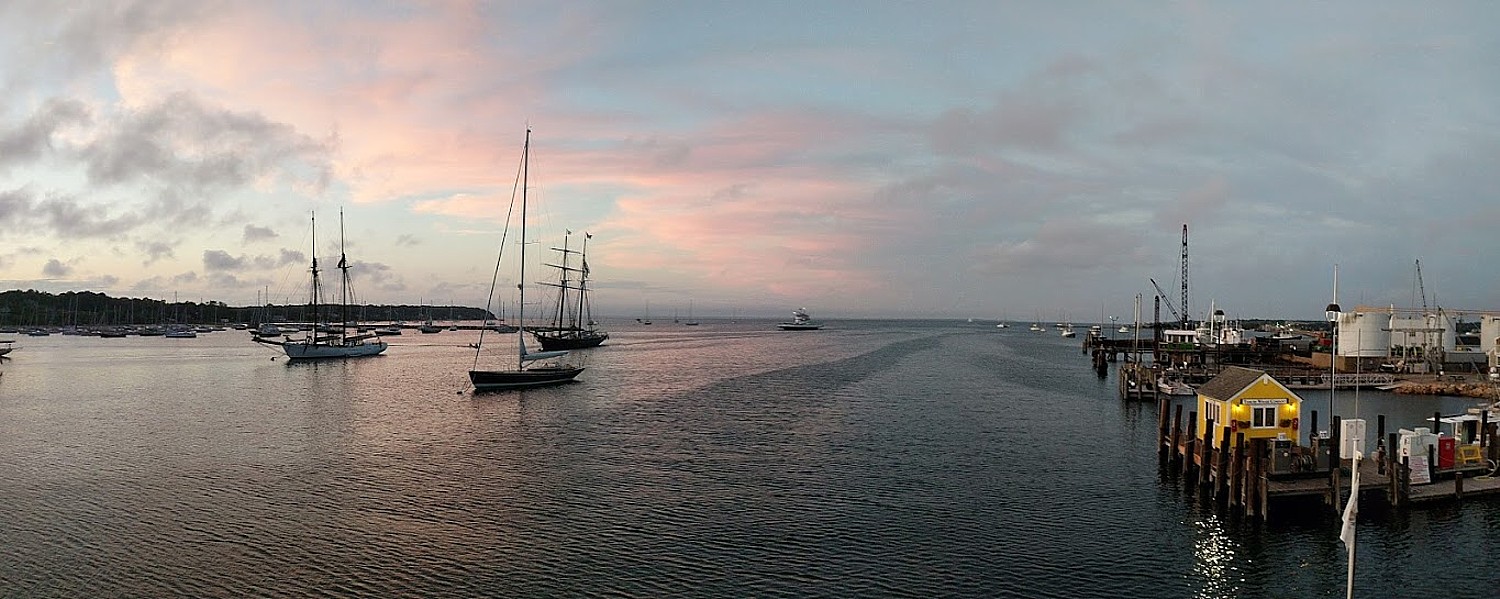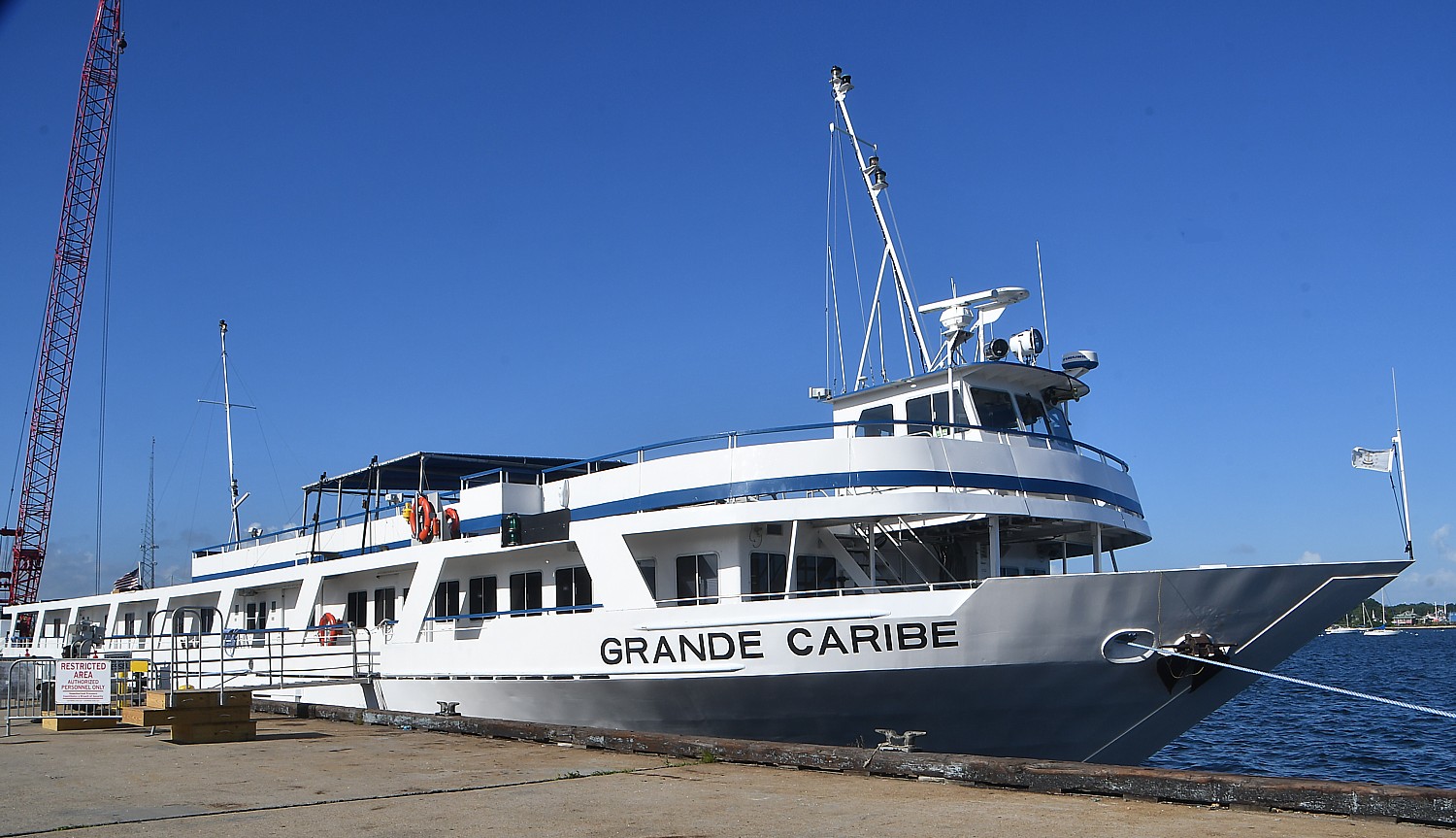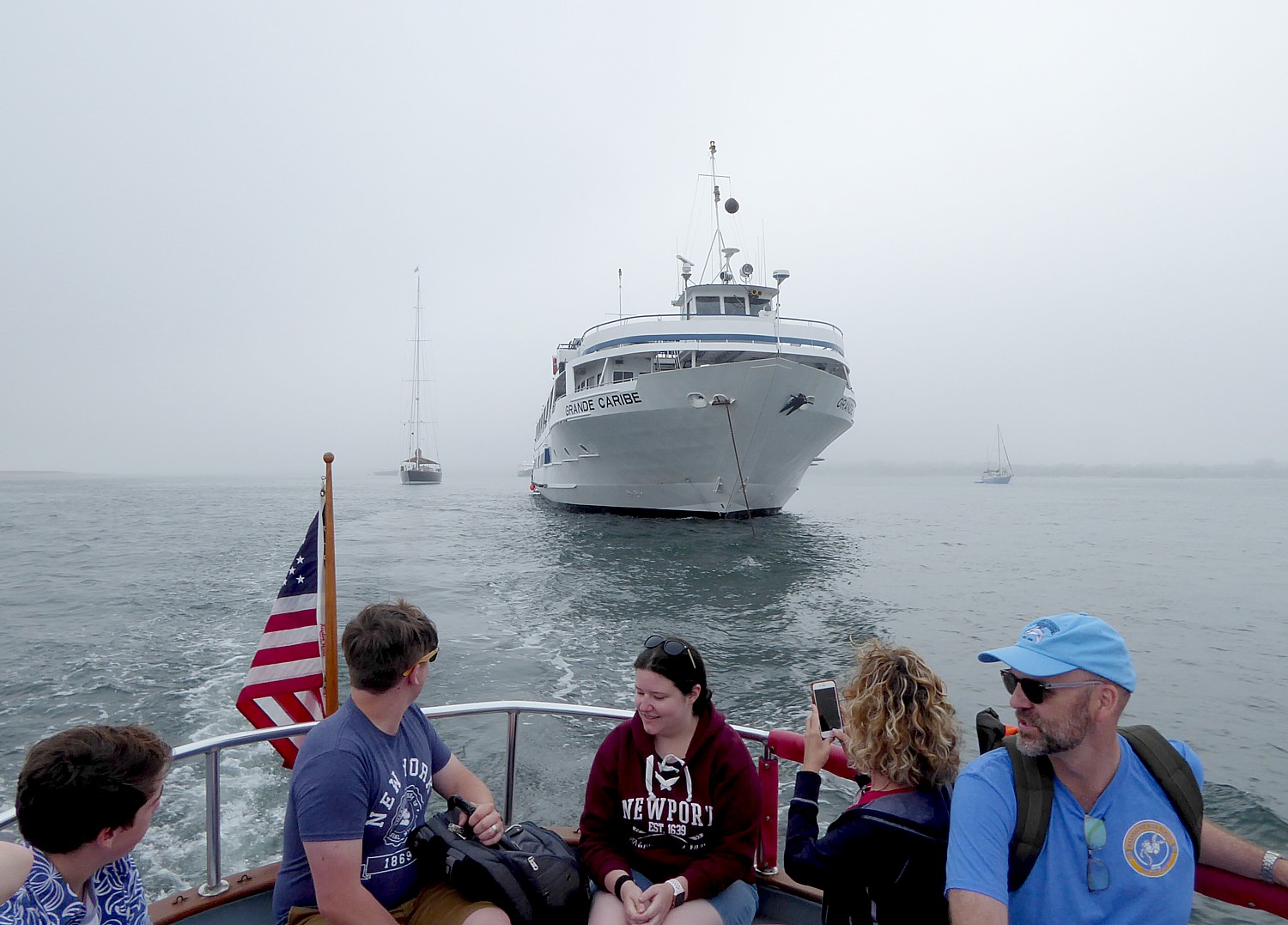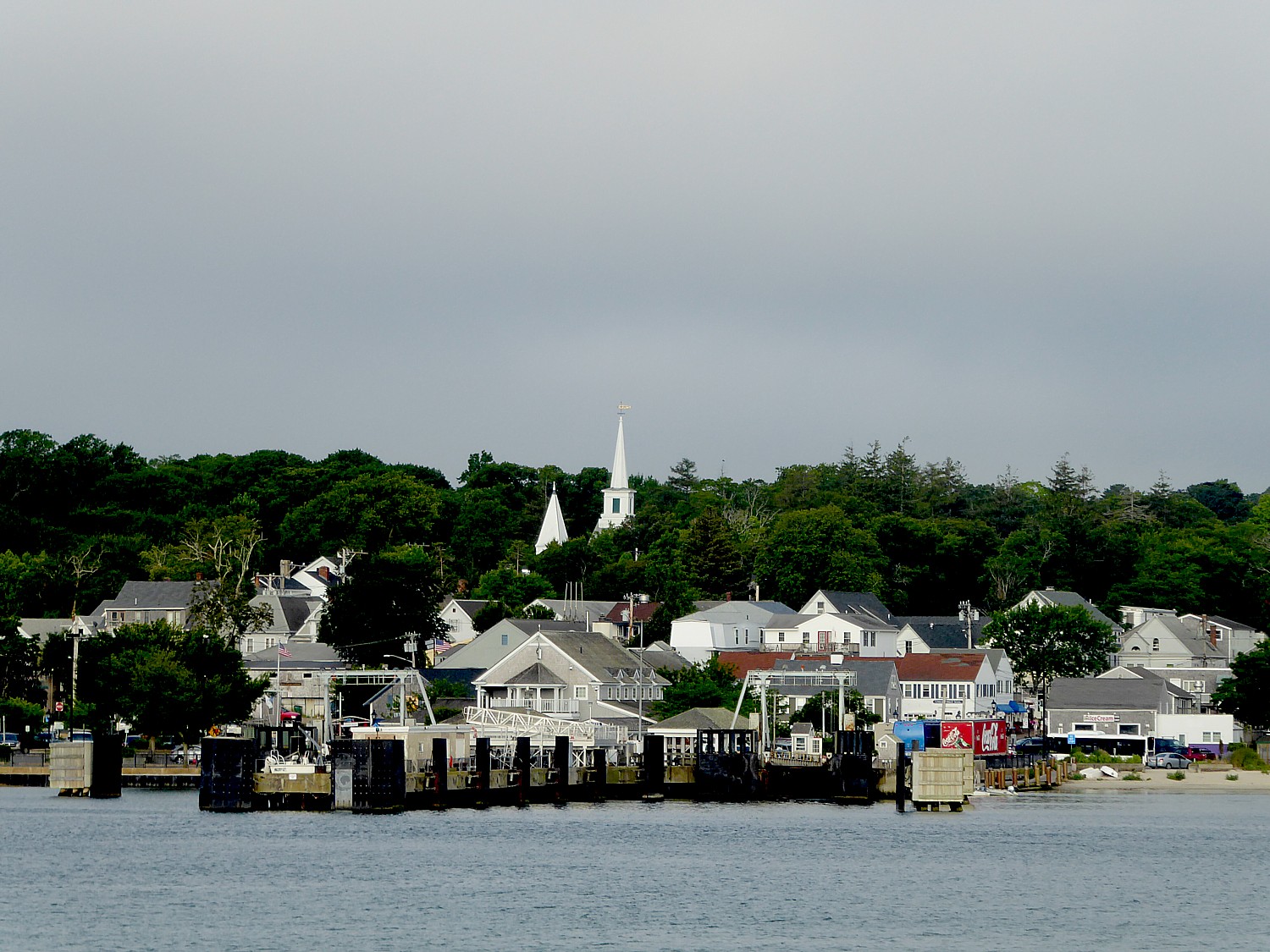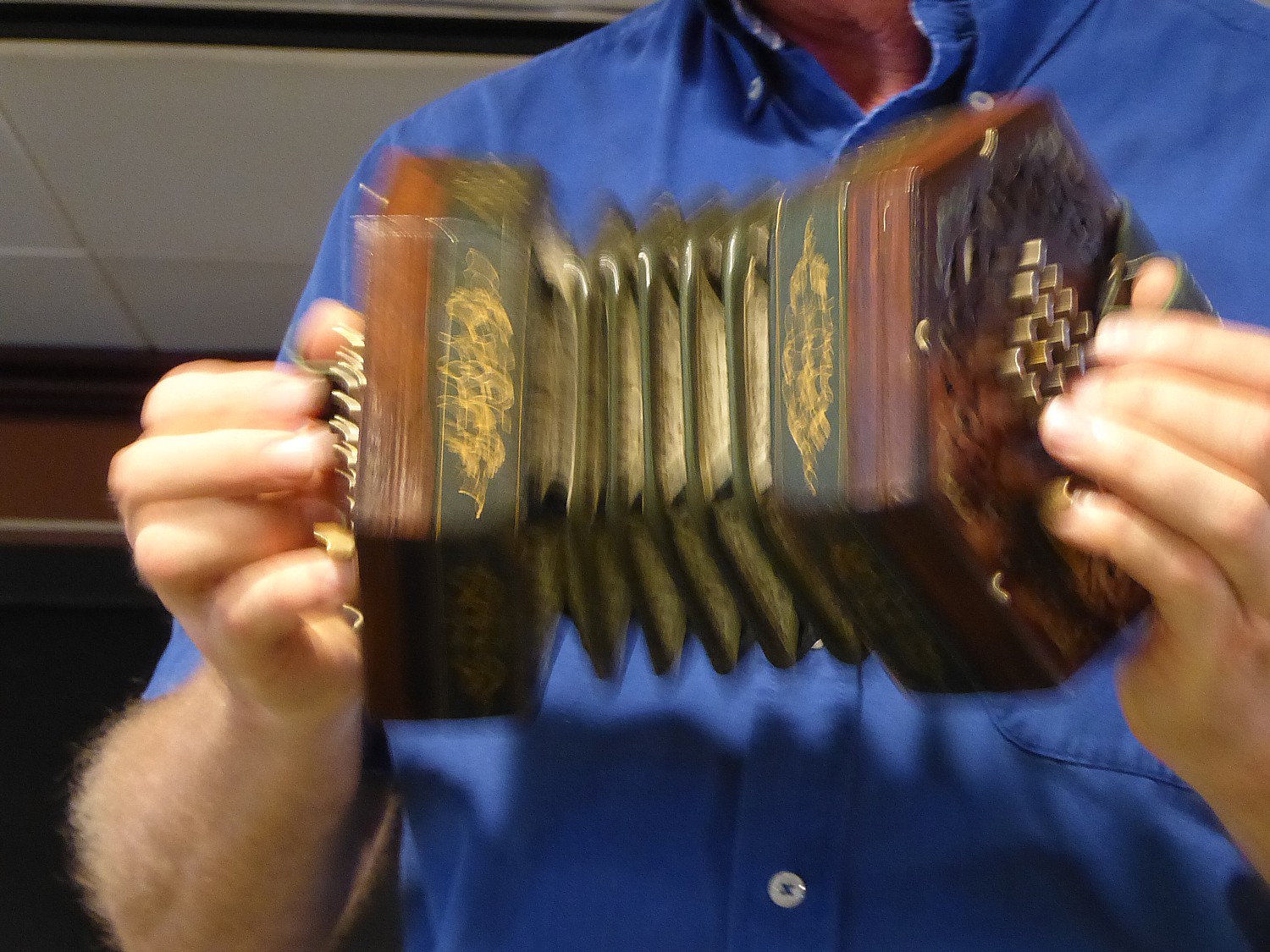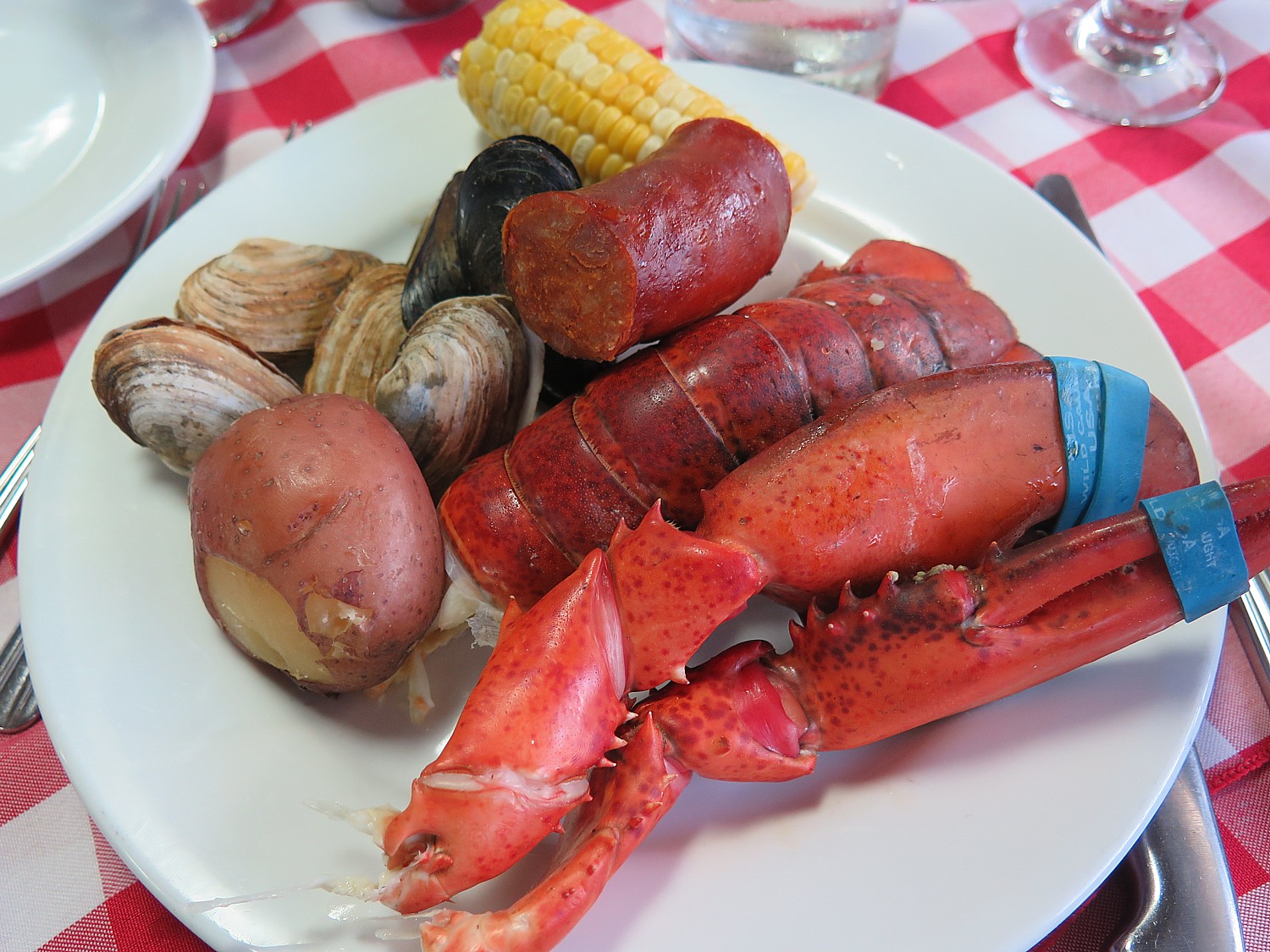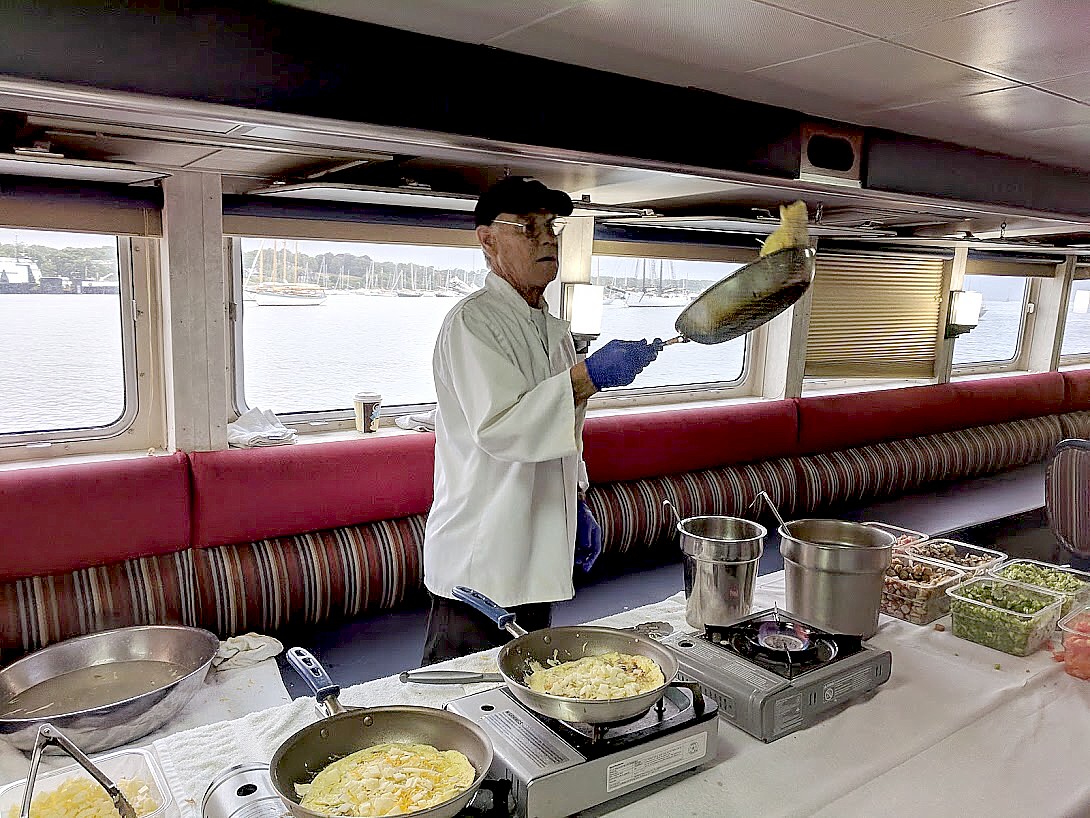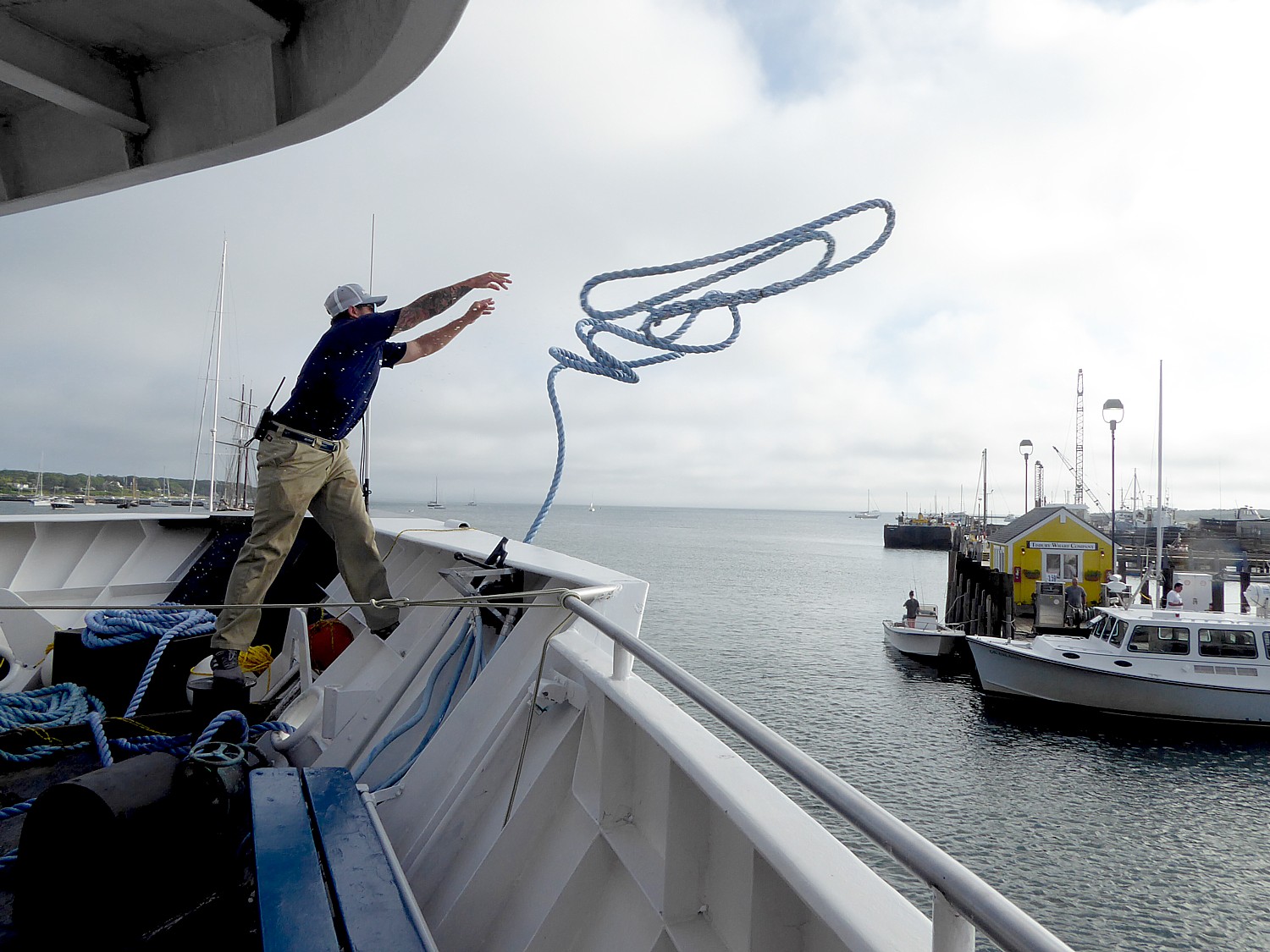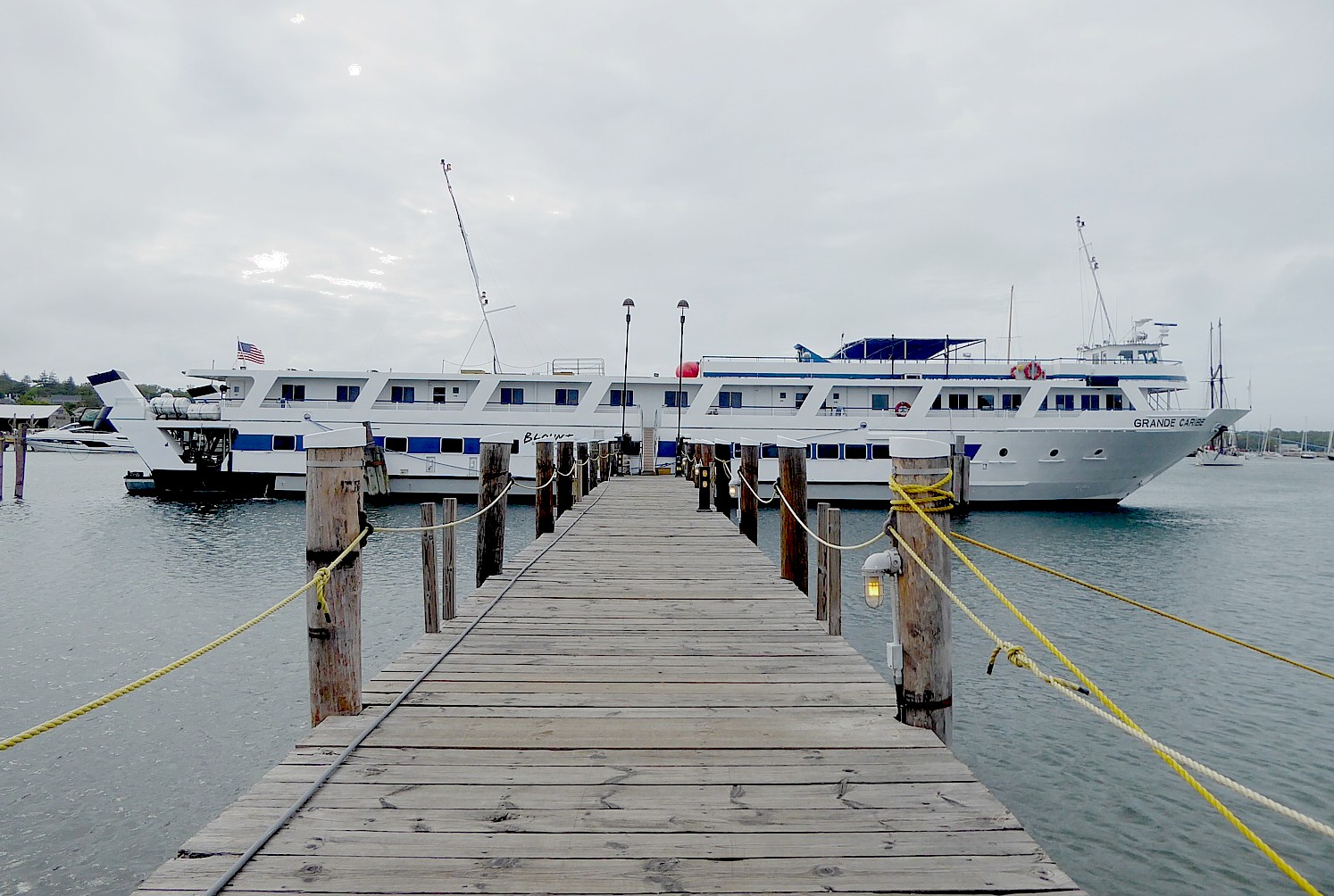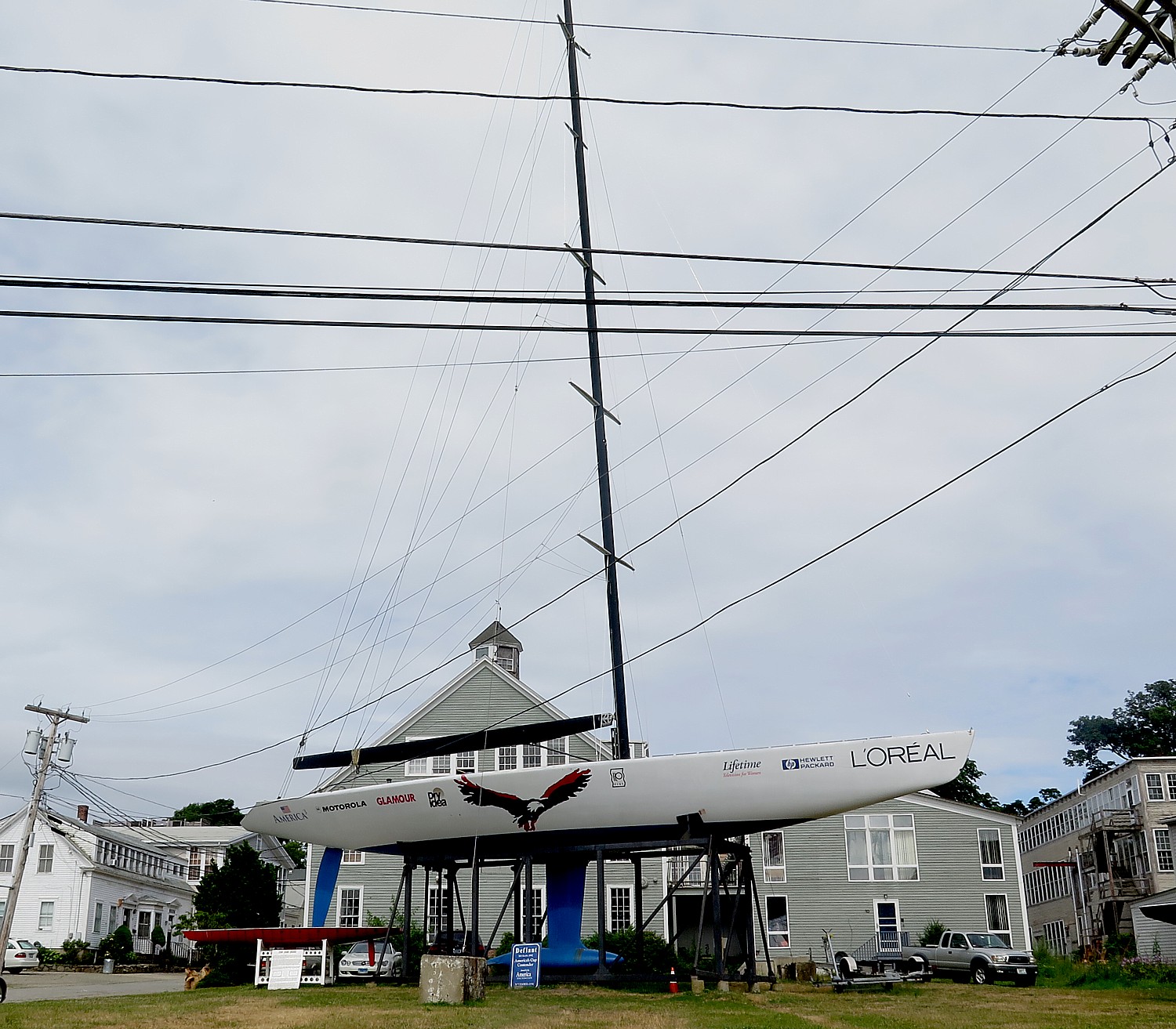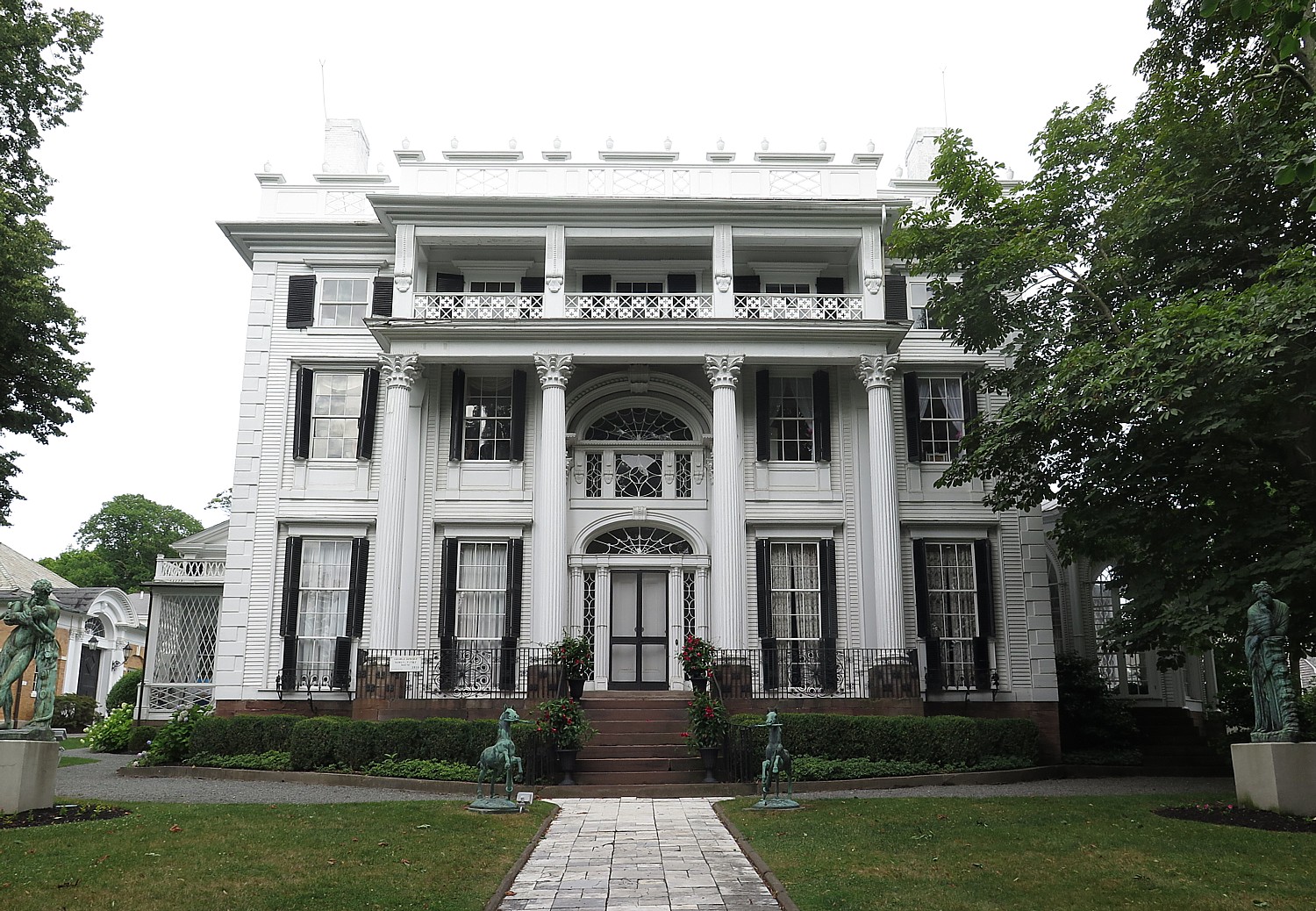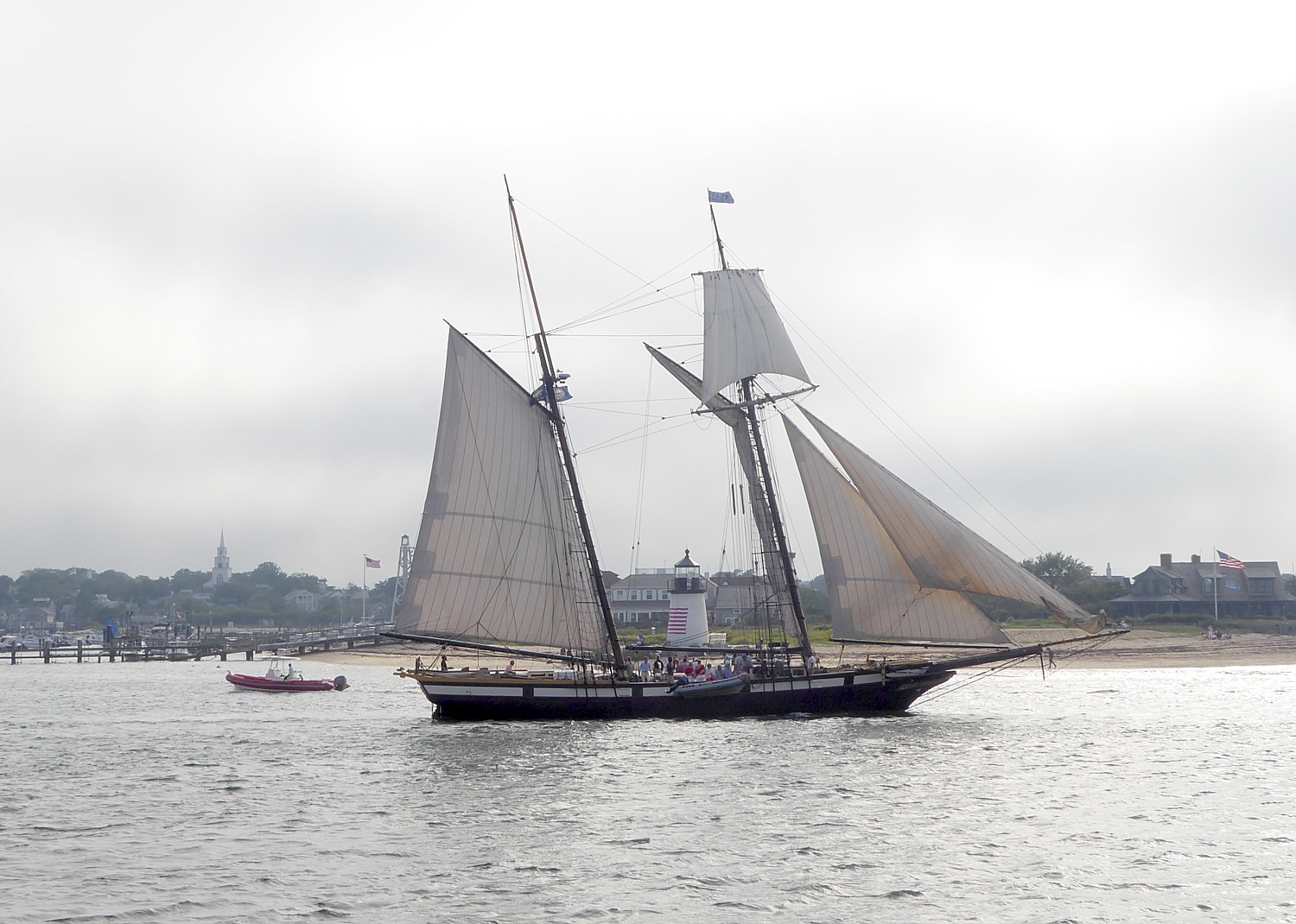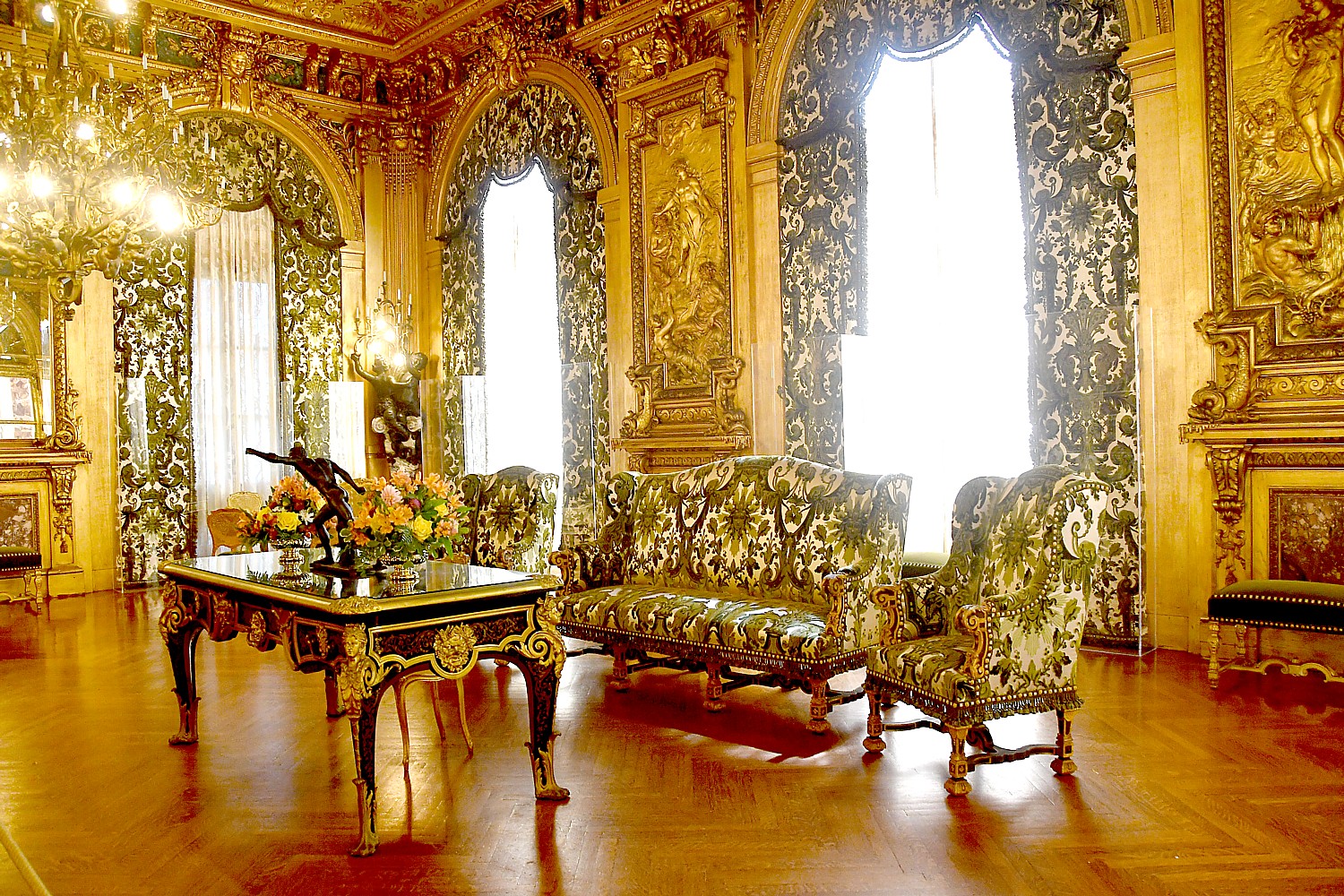
by Karen Rubin & Martin D. Rubin
Travel Features Syndicate, goingplacesfarandnear.com
Each time I visit Newport, Rhode Island, the guided tours of these Gilded Age mansions get better and better, more immersive into the lives upstairs and downstairs, more intriguing, and the relevance to society today more apparent. The gap between rich and poor hasn’t been this great since Cornelius Vanderbilt II built his palatial summer “cottage,” The Breakers.
Newport is still a playground for the rich – it is the reason it is the home to the International Tennis Hall of Fame and considered the sailing capital of the country, why it is so associated with classic cars – but the interesting thing is you don’t have to be rich to play, too.
This most recent visit to Newport comes as a port of call on the second day of Blount Small Ship Adventures’ week-long voyage to New England islands. We have a full day to explore, and sailing in gives a very different perspective.
We also are able to experience Newport from the perspective of how well the destination accommodates visitors with mobility issues.
Our ship, Grand Caribe, docks at Fort Adams State Park, “America’s largest coastal fortification,” a short stroll to a launch or a water taxi to the “downtown”.
Many of our fellow passengers are taking the island tour that the ship offers, which will include a stop at The Breakers, and the cruiseline had also arranged a 2-hour sail aboard an America’s Cup classic yacht (which had to be canceled because of weather). But I have some particular goals for our day in Newport.
We are met by Andrea McHugh from Discover Newport who has organized an itinerary to maximize our time gives us our own island tour (as well as the gossip of which tech billionaire has just bought which house, and how Jay Leno, who visited and attended events at the new Audrain Automobile Museum (which we will visit), passed an oceanfront mansion he liked and bought it on the spot, and now is seen regularly tooling around).
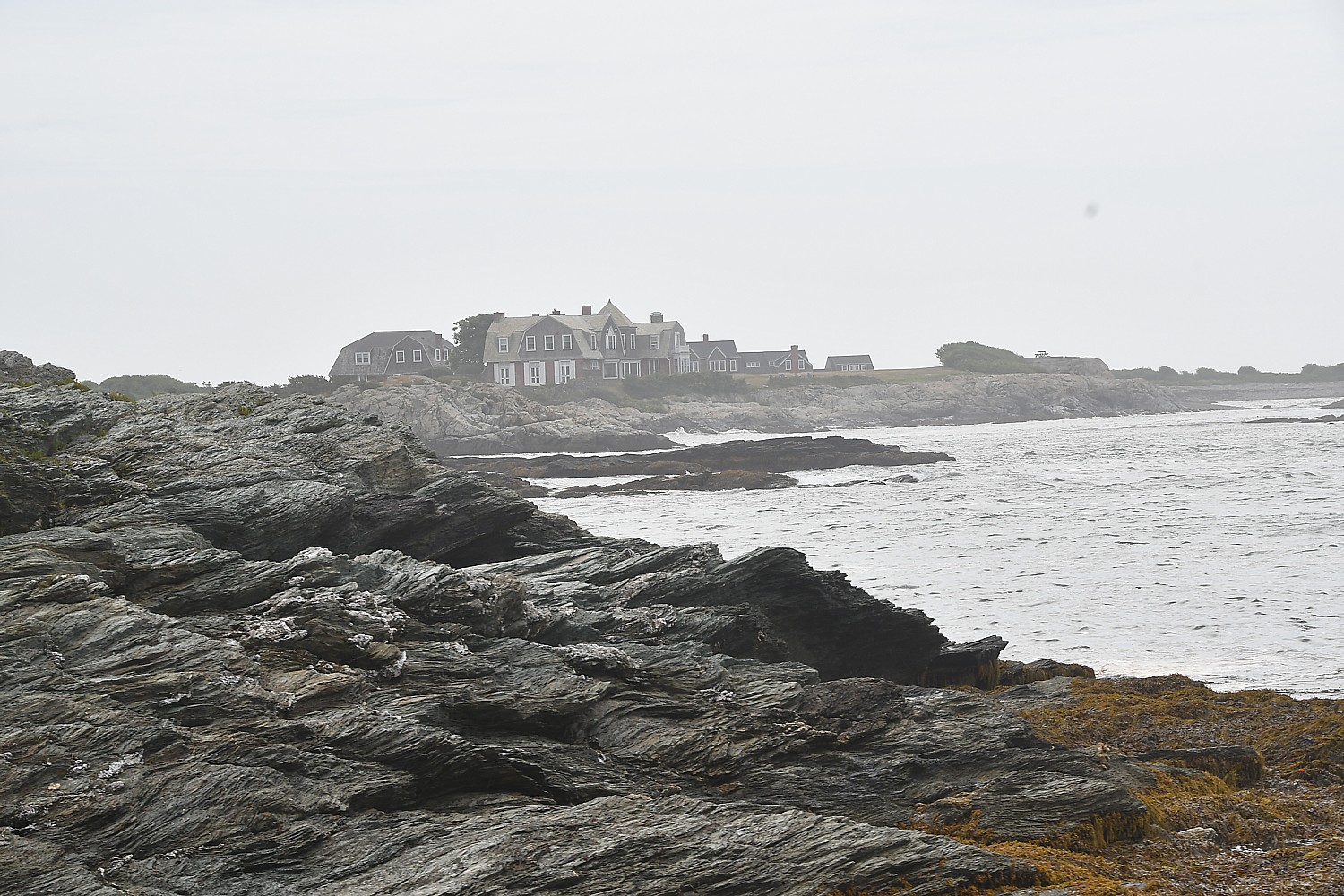
We drive along the magnificent 10-mile long Ocean Drive with its scenic views and rocky shore, and pass the driveway into Hammersmith Farm, the Auchincloss estate where Jackie married John Kennedy. It used to be open to the public with a fantastic exhibit of the Kennedys but was acquired by Peter Kiernan (notable for the Robin Hood Foundation, funded by John Jr.), and is no longer open.
We pass Beechwood, a mansion once owned by the Astors and for many years, where actors played their parts in period dress. It is now owned by Larry Elllison (Oracle), who, we are told, is planning to open part of the mansion as an art museum.
We pass Belcourt, once owned by Oliver H. P. Belmont (who became the second husband of Alva Vanderbilt), which was purchased in 2012, by Carolyn Rafaelian, who has spent a considerable sum on a multi-year restoration and has reopened it for public tours.
The Breakers
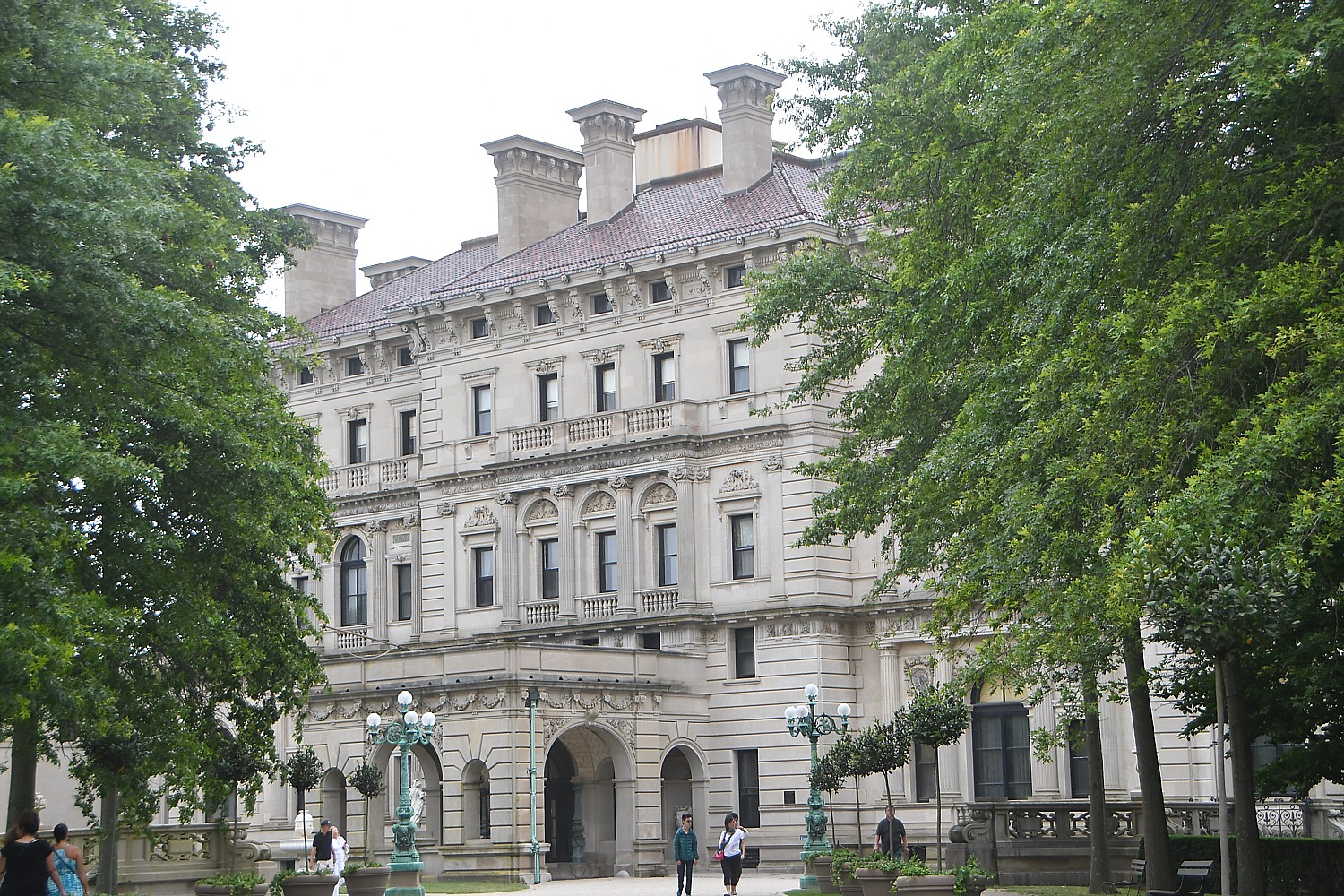
We arrive at The Breakers, probably the most famous (and emblematic) of the Newport Gilded Age mansions that line Bellevue Avenue. It has a new visitor center which is really well done – barely visible from the street, it blends in wonderfully architecturally while affording a very comfortable (air conditioned) place to pick up tickets (take advantage of the multi-ticket options offered by The Preservation Society, which operates 10 of these glittering Newport Mansions, each with special exhibitions and presentations (see NewportMansions.org), refresh at a delightful café (sandwiches, $9.95), and utilize accessible restrooms (before, it was difficult for people with mobility issues to access a bathroom on property).
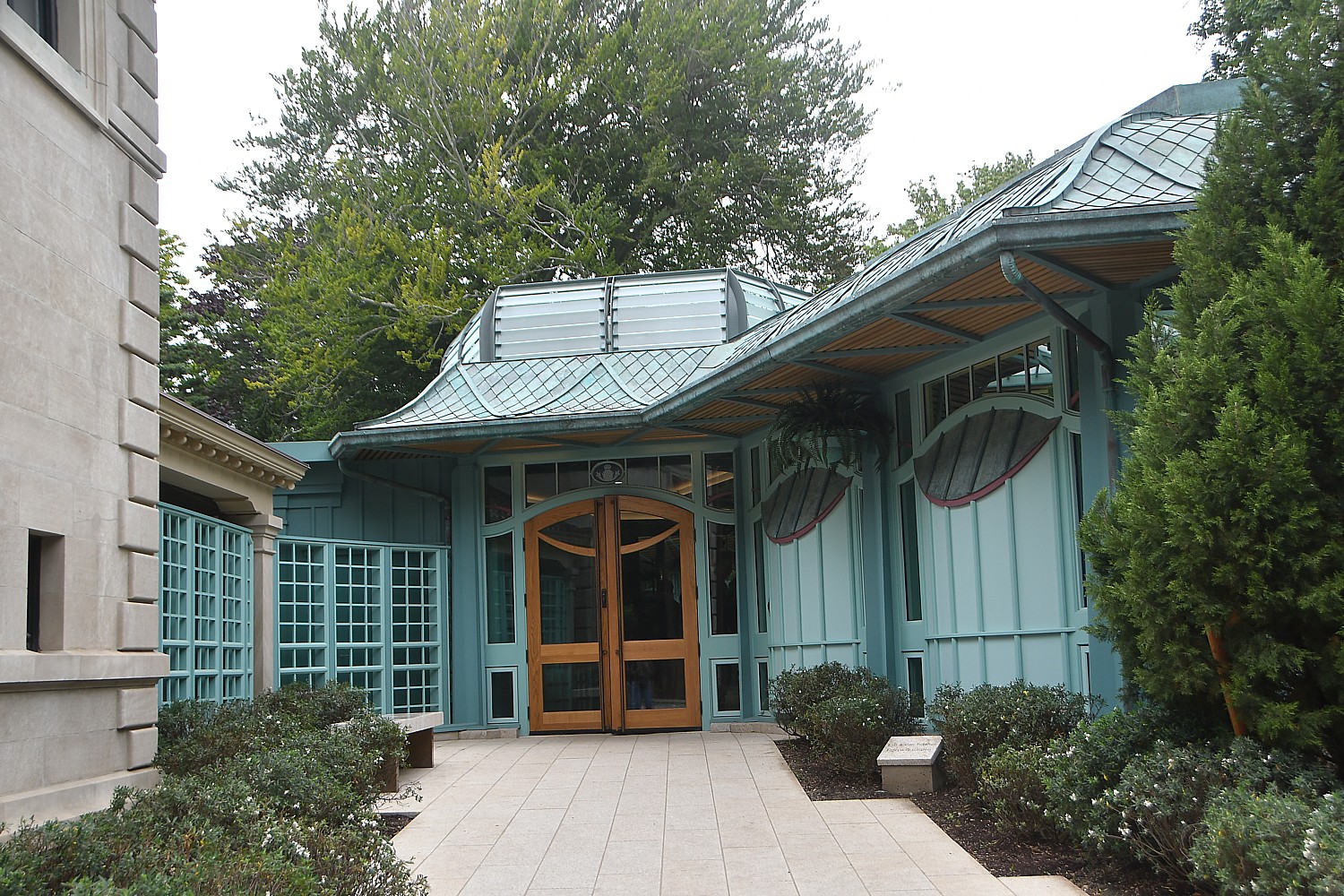
Each time I visit, I find new things to appreciate and understand– audio-guides, for example, which replace the scheduled docent-led tours so let you tour at your own pace, are endlessly fascinating with opportunities to click on specialized topics. (A free app, Newport Mansions, let you download the commentary on a smart phone even when you aren’t touring the property.)
(The audio-guide lets you know that people who can’t climb the stairs can ask a docent to escort them upstairs in an elevator.)
Built by Cornelius Vanderbilt II (the grandson of “The Commodore,” the founder of the fortune, who turned a ferry boat into a shipping empire into a railroad empire), this breathtakingly grand, eye-popping, 70-room Italian Renaissance “cottage,” designed by Richard Morris Hunt, replaced a wooden structure that burned down. This was 1895, and the United States was jockeying for a position as an industrial power on the global stage. Hunt, the commentary relates, had a vision for an architecture expressing an American Renaissance, one that was classic, grand in scale, but that which reflected the hope and optimism of America.
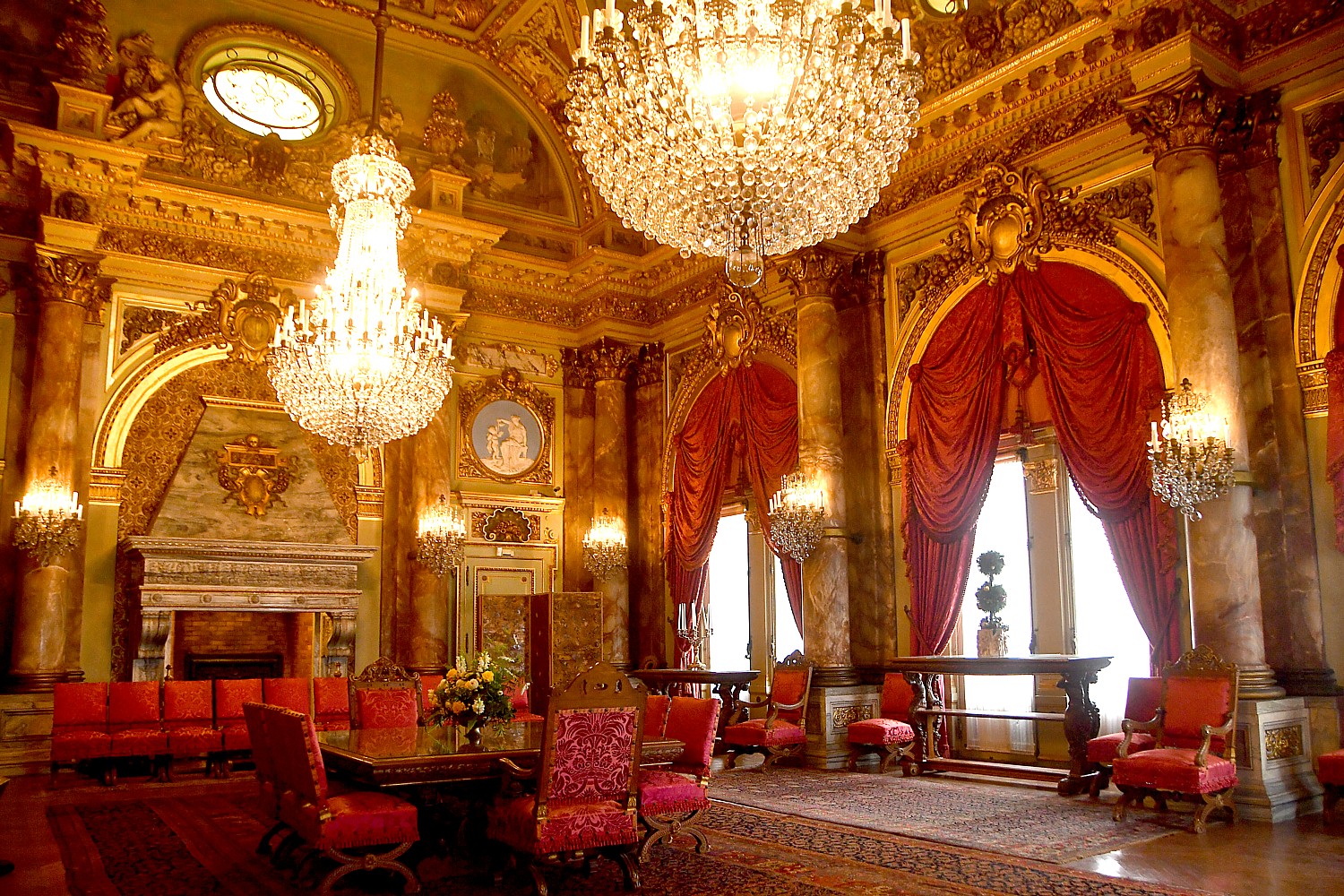
It is mind-boggling to recall when you see the gilding, the carefully carved wood, the marble, the artwork, that this palace (they called it a “cottage”) was only used about eight weeks of the year, during “the season.” The Breakers would have had 40 staff in summer (Newport had 2,000 servants, mostly immigrants).
The Breakers is as much an architectural and artistic treasure as a touchstone to social, cultural and political currents of the Gilded Age.
We learn about the family and the social structure of Newport: Mrs. Alice Claypoole Gwynne Vanderbilt’s bedroom, for example, also functioned as an office from which she ran the home.
Newport was actually run by women, we learn. These grand homes were designed to present their wealthy daughters (heiresses) to be snapped up for a favorable marriage.
Dressing was important. Women would have to change something like seven times a day (a riding habit, tea gown, bathing outfit, tennis, golf, sailing). Newport was the first place women played outdoor sports; whole new fashions were created.
The Breakers had 15 bedrooms and 20 bathrooms (we see one bathtub, carved from a single block of marble that was so cold, it had to be fully filled and drained several times before it would be warm enough to bathe in.)
We see the servants corridors, hidden closets and back stairs. “Female servants were invisible.”
When we arrive in daughter Gertrude Vanderbilt’s bedroom, we learn that she was upset to learn she was an heiress. She preferred to be an artist, and became a sculptor, an art collector and patron and, in 1931, founded the Whitney Museum. (Here, I click the audio guide for more detail on specific things: Gertrude was on the forefront of the New Woman, an educated girl. The idea to become an artist came to her in a dream.)
We come to the mezzanine overlooking the grand staircase. (People who cannot climb stairs can ask to be escorted to an elevator.) “Gilded Age Newport was built, managed, and maintained by women. It was the backdrop for the presentation of women” at a time when a woman’s fortune depended upon making a favorable marriage.
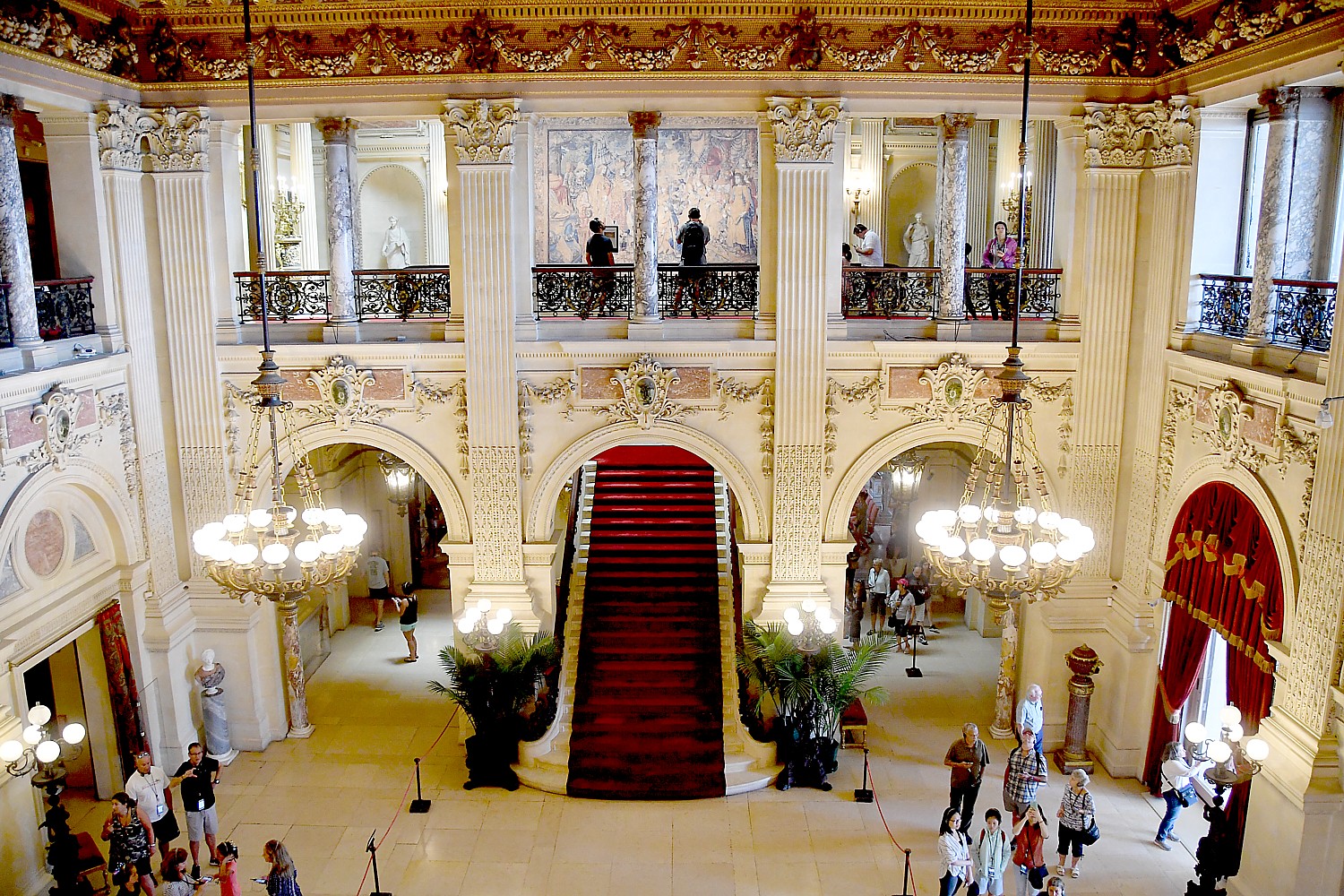
We learn that the grand staircase stairs were built (and even rebuilt) to be two inches shorter, so the young debutantes could be presented in their gowns without fear of tripping.
At this portion of the tour, you can click on the audio guide to hear more detail about how the Vanderbilt’s attained such wealth and privilege (but it is really, really hard to keep the players straight without a scorecard – so many have the same name like British royalty).
The Commodore left the vast majority of his enormous fortune to his eldest son, William Henry Vanderbilt (“Any fool can make a fortune; it takes a man of brains to hold onto it,” Cornelius Vanderbilt said.) Though he outlived his father by just eight years, in that time William doubled the Vanderbilt wealth from $100 million to $200 million.
In the oddest quote on the audio-guide, William Henry Vanderbilt explains why he sold controlling stock of the Vanderbilt empire to a syndicate headed by JP Morgan: “The care of $200 million is too great a load for any brain or back to bear. It is enough to kill a man. I have no son whom I am willing to afflict with the terrible burden.” The commentary adds, “Without a single visionary leader like the Commodore, there was no one to invest in the next new technology. Automobiles and airplanes replaced the railroads, the once vast fortune was split and shared among generations of descendants.”
When we visit the kitchen, we get to appreciate some of the modern innovations of the house. The first Breakers burned down so when Cornelius II rebuilt it, he had the kitchen separated from house and no burners. Zinc, the stainless steel of its day, covered the worktable. There was a separate, smaller room which could be kept cool, for preparing pastry.
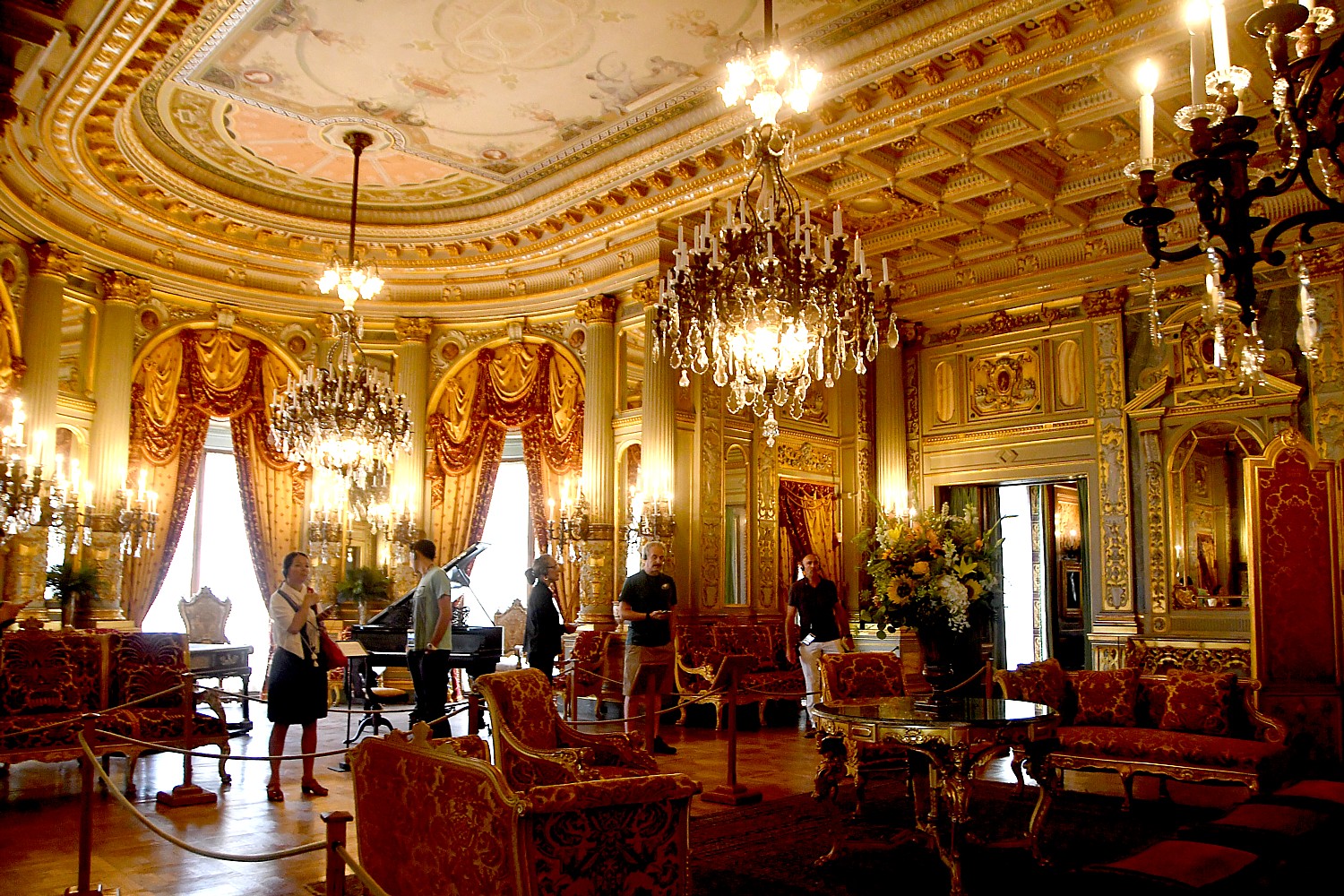
It is worthwhile to appreciate that as we see the trappings of obscene wealth, privilege and power, we also get to appreciate that the servants – who were mainly immigrants – saw their position in these mansions as improvements, and many were able to embrace the American Dream and move up in station and class. The Breakers’ chef, we learn, started as a kitchen boy and became known as the Omelette King.
The Butler’s pantry, a two-story affair, had a safe for the butler to lock the silver away. The butler, we are told, was like the captain of ship.
Leaving The Breakers, we walk down to the Cliff Walk, the most visited attraction in Rhode Island, and for good reason. This is a delightful walkway along the cliffs (mostly paved and accessible for someone who uses a cane or, as I urge instead, hiking sticks), behind the grand mansions such as The Breakers, and free to enjoy. It extends 3.5 miles all the way to Doris Duke’s Rough Point (where the walkway becomes more scrappy). Today, we only get a taste of it, in order to conserve time and energy.
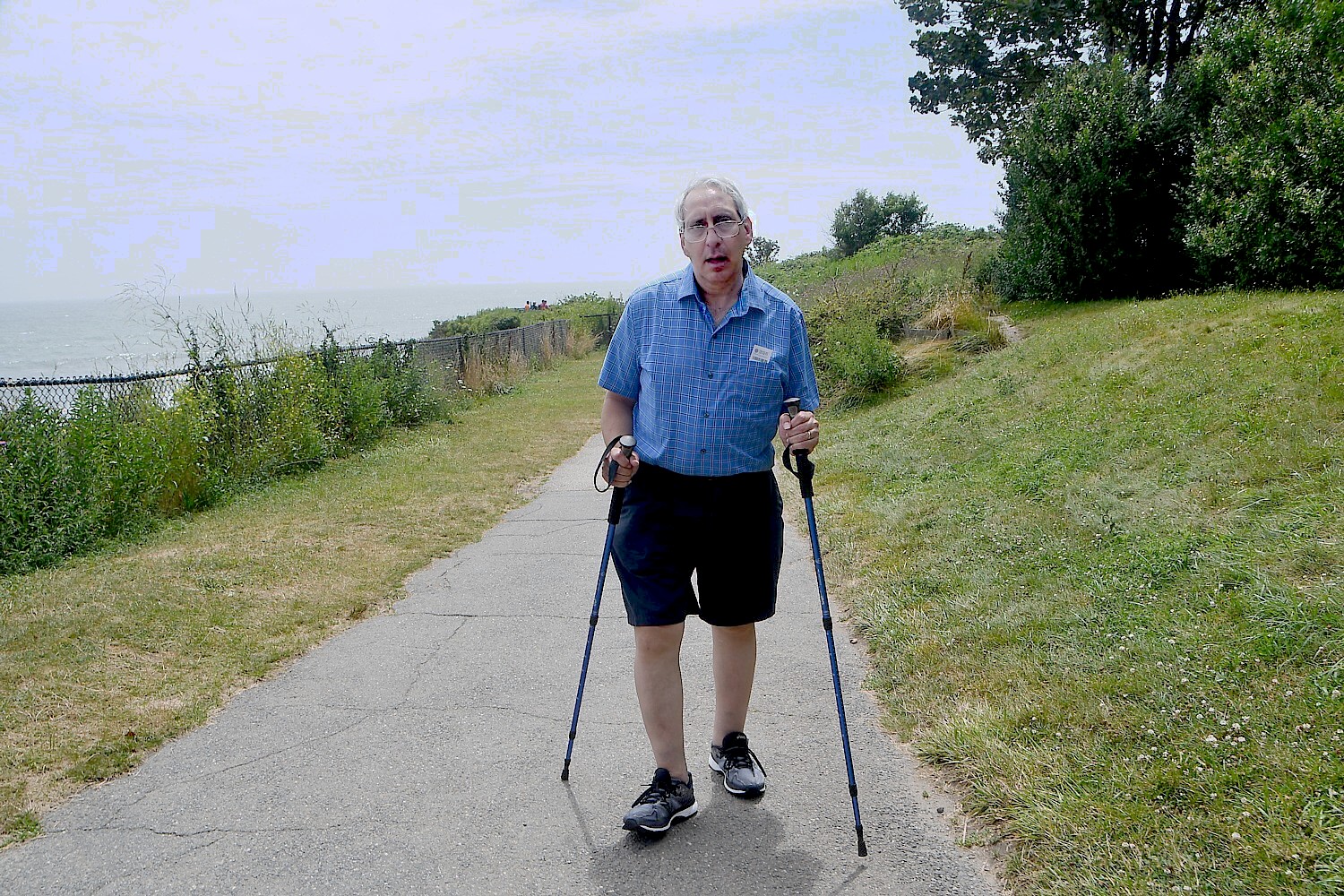
Marble House
If The Breakers is about patriarchal wealth, power and privilege, Marble House, built before The Breakers by Cornelius II’s sister-in-law, Alva Erskine Smith Vanderbilt, tells the story of burgeoning feminism and what happens when a smart, ambitious woman has few outlets for her vast talents beyond making an advantageous marriage.

Marble House (which we reach by hopping Newport’s delightful trolley-style bus) was designed by the architect Richard Morris Hunt (who also designed The Breakers). Inspired by the Petit Trianon at Versailles, Marble House was built between 1888-1892 at a cost of $11 million of which $7 million was spent on 500,000 cubic feet of marble. When it was finished, William Kissam Vanderbilt, the Commodore’s grandson, gave the house to his wife as a 39th birthday present.
Alva built Marble House to be “a cottage like nothing Newport had ever seen.” As it turns out, Alva Vanderbilt was also like nothing Newport had never seen.
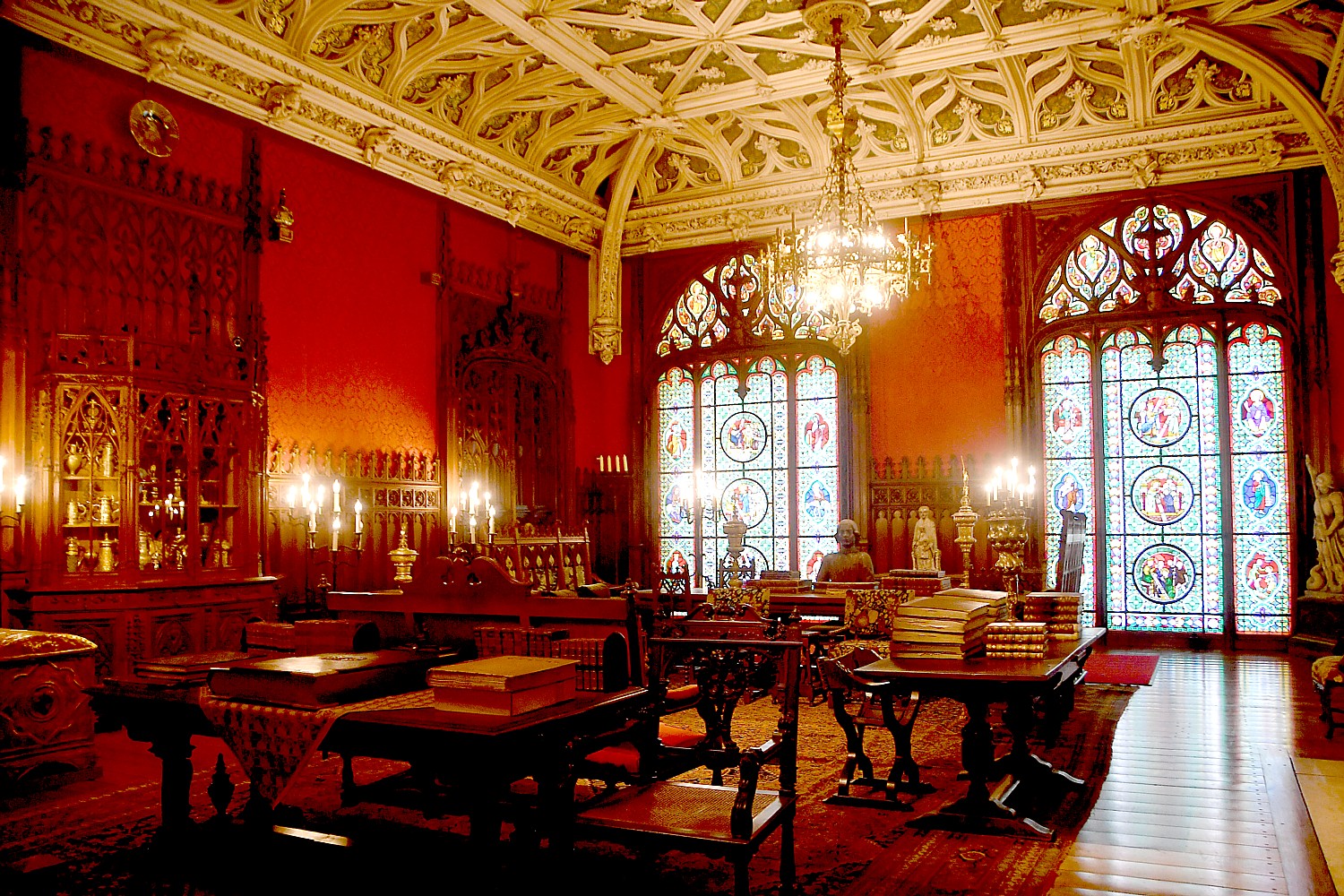
The Gothic Room featured an important Gothic collection from Europe, which Alva purchased “en bloc” – the whole caboodle. “She considered herself equal to European collectors but didn’t want to collect over generations.” The room was designed and executed in Paris – then reassembled here piece by piece.
At a time before there were public museums, this room became a private museum.
The most revealing room into Alva’s soul is the library (the “morning room”), where you see photos of Alva’s children and a portrait of Harold, born when her oldest, Consuelo was 7, who came back one day to find she had a baby brother and was told “God had sent him to us.”
The room is Alva’s feminist declaration, decorated with images of goddesses representing beauty, wealth and power. She wove into the frame and the fabric of the room images of women’s accomplishment – women holding a quill pen, Cleo, the Greek muse of history, female images of learning and the arts – the four corners showing (mythical) women in chemistry, botany, astronomy.
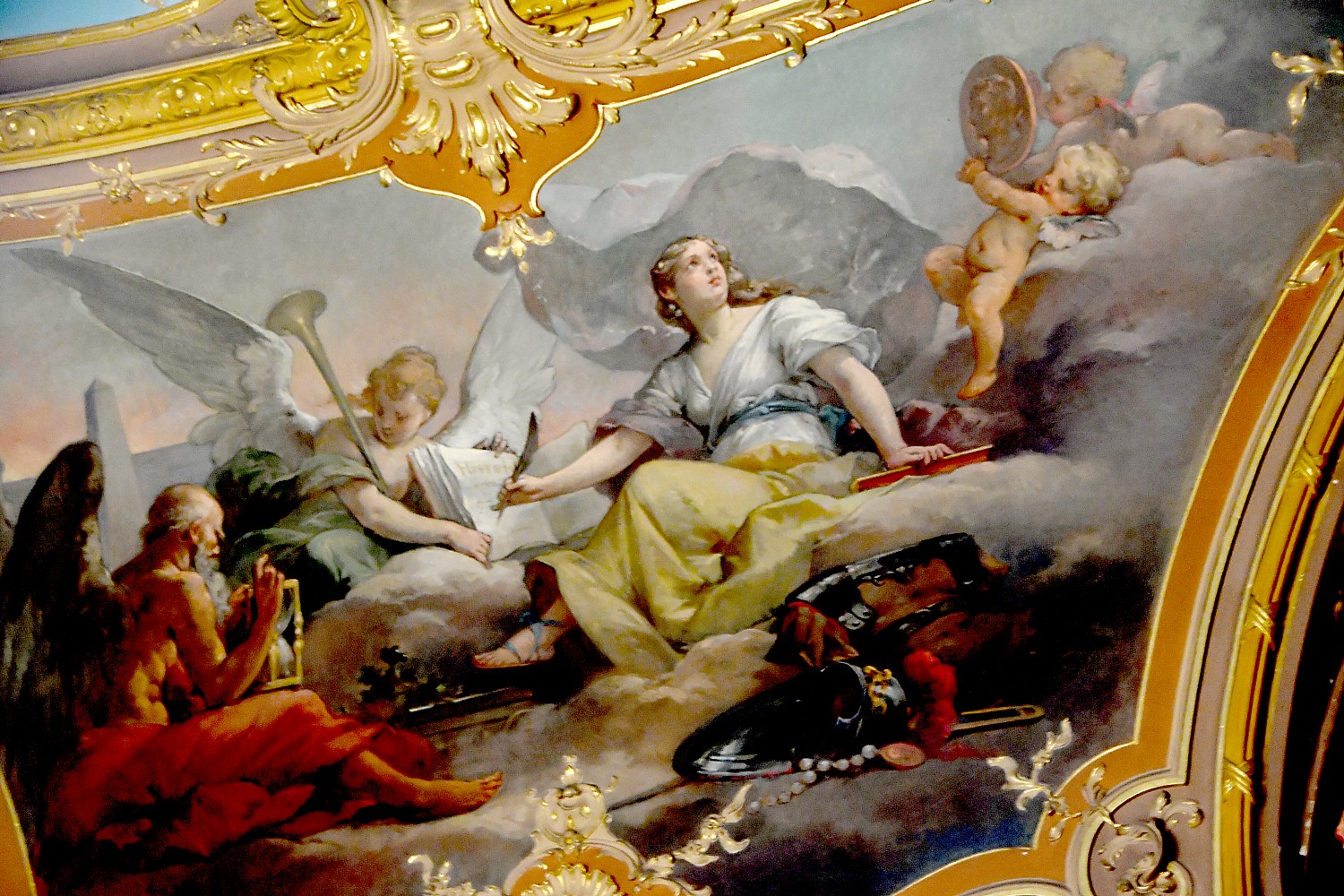
“In education, women have made tremendous strides,” she said. “It is not so long since women freed themselves from their man-made belief that it was unwomanly for a woman to have an idea of her own.”
She also said, “A man’s brain is not half a brain and we are the other half. Blending of the two will make a better whole.”
Her bedroom also was a display of the power she coveted – a bed on a throne-like platform, and images of Athena – goddess of wisdom and war.In this period, though, she saw social standing – that is, marriage to wealth – as a woman’s only means to power and independence. She applied this to her daughter, Consuelo, and raised the child to marry royalty.
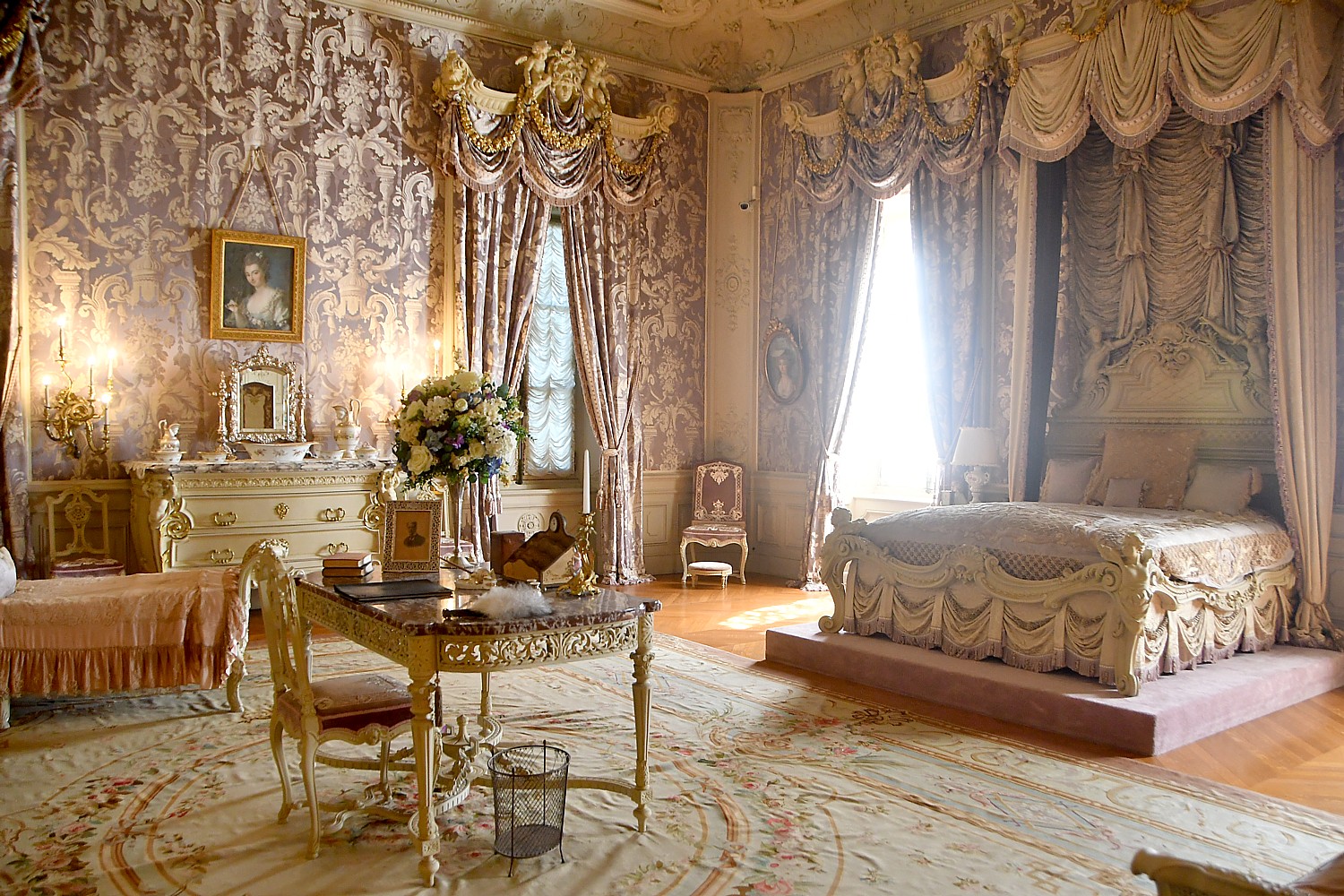
Consuelo seems to have been Alva’s obsessive focus. You hear how she was groomed to be married off to European royalty – from childhood forced to wear a steel rod from her neck to waist with a strap around her shoulders, to force her to sit up straight.
From her quotes, Consuelo seems to be fully aware of how she was being dominated by her mother, yet was a dutiful daughter, very close to her mother and understanding. We visit her austere room decorated by her mother which, she says, “reflected in my mother’s love of me.”
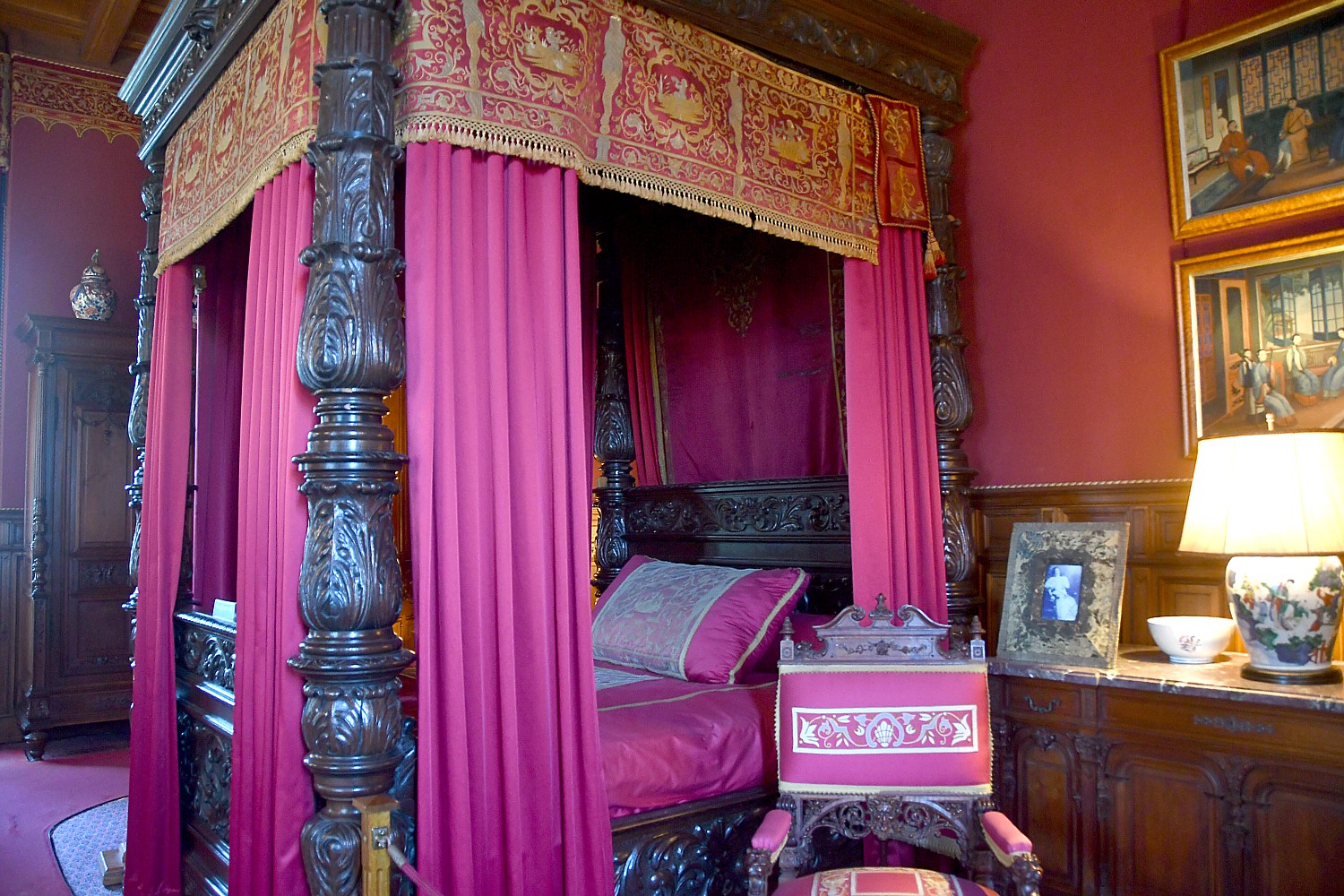
We see the guest room – the only one in this fabulous mansion – decorated in rose silk, with an 18th century bed. The most famous guest was, of course, the 9th Duke of Marlborough, Consuelo’s intended. We learn there is only one guest room in the house because people who would visit the house either had their own “cottage,” rented for the season or stayed in a hotel. “Marble House is built for the family.”
Consuelo “reluctantly accepted a proposal from the Duke of Marlborough.” She was one of the “Dollar Princesses,” American heiresses who married foreign royalty.”Consuelo Vanderbilt not the first or the last, but she was the best known.”
These marriages, “were a melding of the old world and the new world. They enabled royalty to maintain property and palaces for another generation.”
Indeed, the Gilded Salon – literally painted in 22 carat gold, the very epitome of Gilded Age – had a featured role in Duke’s marriage proposal.
But after Consuelo was married off to British royalty, Alva acted for herself, divorcing William K in 1895.
My favorite quote from the audio guide, “I was the first of my set to marry a Vanderbilt and the first to get divorced – but not the last.” Alva Erskine Smith of Alabama felt herself a pioneer for her class, a female knight reassuring others. “Mine was the first, but the first of many.”
She ditched William K. Vanderbilt to marry her husband’s best friend, Oliver H.P. Belmont, moving down the street to Belcourt.
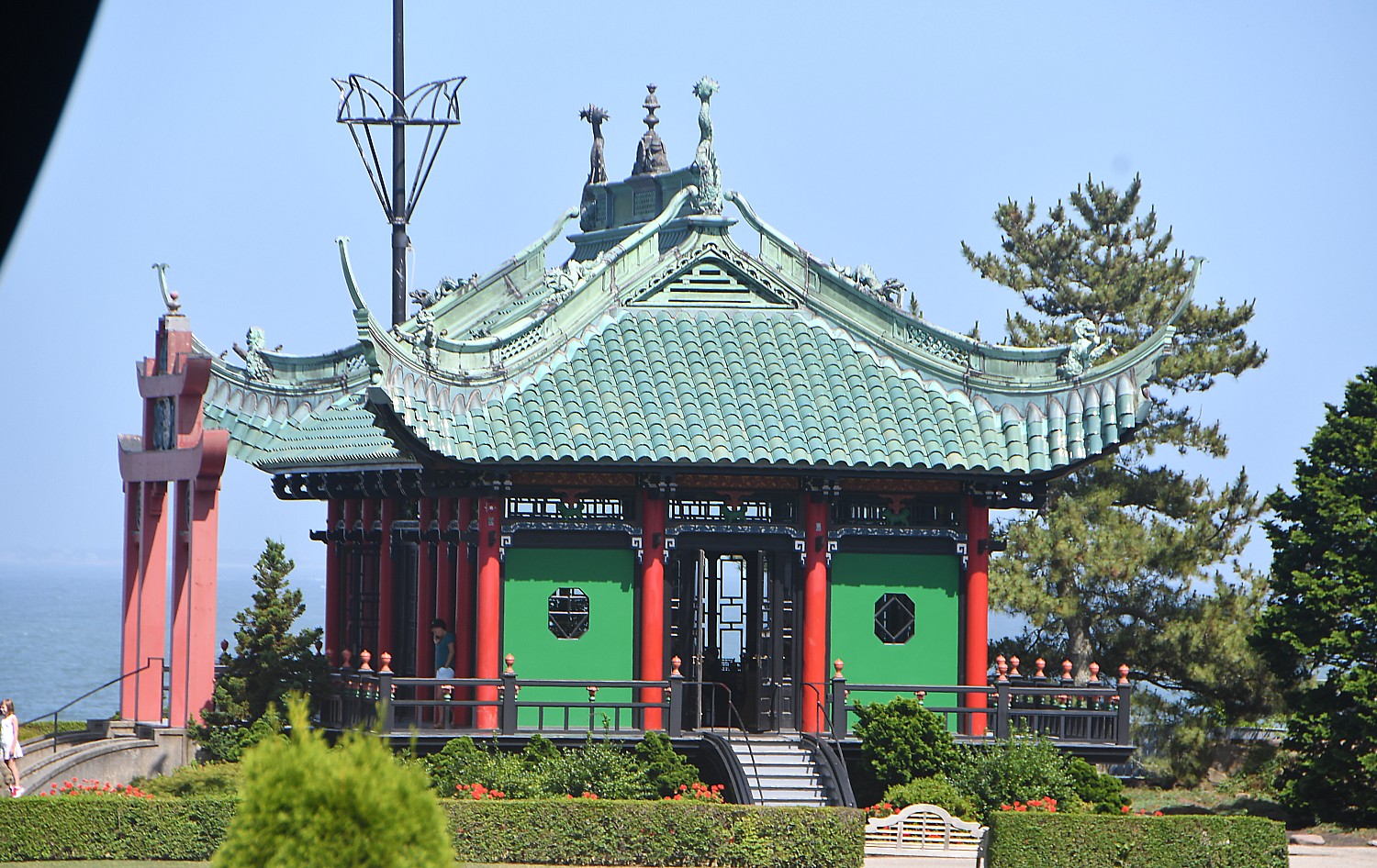
After Belmont’s death, Alva reopened Marble House and had a Chinese Tea House built on the seaside cliffs. She became active and a major donor to the Women’s Suffrage Movement, holding rallies in 1909 at Marble House.
She raised money for the cause by opening Marble House to the public: “Shop girls could mingle with socialites” for the price of a $5 ticket (which would have been equivalent to $500 in today’s money).
Alva insisted, “Women shouldn’t marry until we get vote,” a pronouncement considered hypocritical for a twice-married woman.
Following her mother’s example, after 26 years as Duchess of Marlborough living in Blenheim Palace, Consuelo ended her loveless marriage in 1921, giving him $2.5 million a year, and married “for love” a French aviator, Jacques Balsan. (More about these personal relationships in a fantastic photo gallery in the basement.)
In stark contrast to the grand (albeit austere) bedroom that Consuelo occupied, her brothers’ rooms were tiny and spartan; Willy K Jr.’s room was occupied by Marble House superintendent, William Gilmour, who joined the household when he was 16 to be Willy K’s companion.
We visit a trophy room (that had been converted from two dressing rooms that were between Alva’s bedroom and Consuelo’s), that recognizes sons William K., Jr.’s role in pioneering the sport of auto racing in America (he created the Vanderbilt Cup auto races and built the Vanderbilt Parkway which starts across from where he had a home in Lake Success); and Harold Stirling, one of the finest yachtsmen of his era who successfully defended the America’s Cup three times and invented the game of contract bridge. Notably, as chairman of the board of Vanderbilt University, Nashville, Harold supported integration.”He wanted to be associated with positive, progressive thinking.”
In the basement kitchen (capable of feeding 100), we see yet another side of Alva in a quoted segment complaining “how the rich are exploited. When a shopkeeper learned my address, he said he made mistake of the price and added 50%.” This at a time when she paid a French chef (after all, you had to have a French chef), the massive sum of $10,000 (equivalent to $250,000 today).
We see in the cupboard silver trays etched with the children’s names and china made with “Vote for Women.”
In Marble House, too, people who have difficulty climbing stairs can ask to use an elevator, and the docents will find a place to sit and rest, as necessary.
In summer, the Preservation Society has 10 properties open, all with distinctive presentations and exhibits.
Rosecliff, the 1902 “fantasy in terra-cotta”, is presenting “Bohemian Beauty” celebrating the ideals of the Aesthetic Movement, personified by Oscar Wilde who visited Newport twice, with furniture, ceramics, wallpaper, glass, silver, paintings and clothing (thru Nov 4).
(Plan your visit in advance at The Preservation Society of Newport County, 424 Bellevue Avenue, Newport, RI 02840, 401-847-1000, info@newportmansions.org, www.newportmansions.org.)
In addition, there are the homes and heritage sites operated by Newport Restoration Foundation including Rough Point and Whitehorne Museum (51 Touro St., Newport, RI 02840, 401–849–7300, newportrestoration.org).
Tennis, Classic Cars
Between The Breakers and Marble House, we take in some of Newport’s other distinctive attractions:
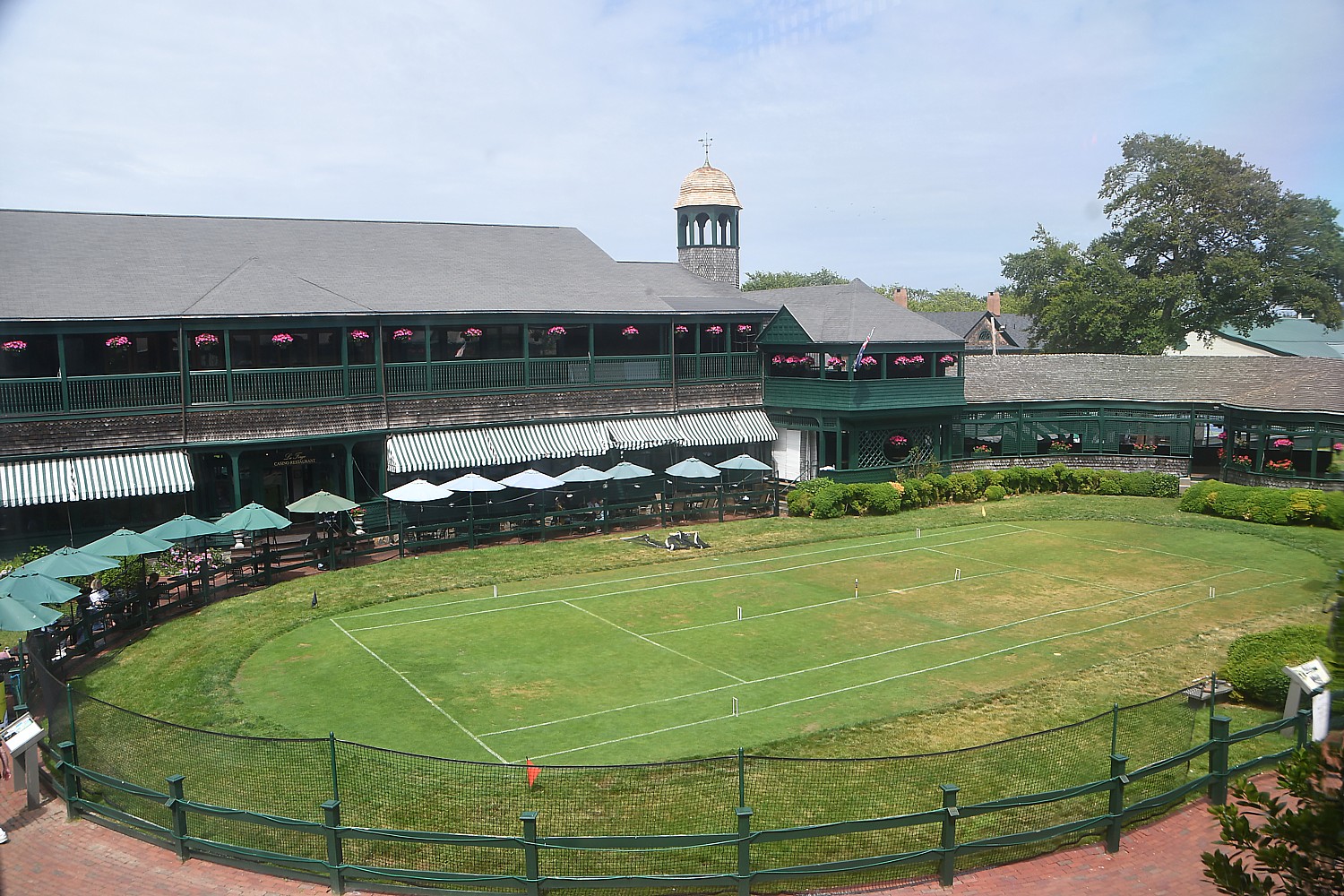
The International Tennis Hall of Fame, which features the original grass court where American tennis began. The museum features 2,000 artifacts spanning hundreds of years of tennis history (such as the patent for the game of tennis signed by Queen Victoria in 1874), displayed in redesigned galleries with some interactive exhibits. One of the newest, most novel exhibits features a hologram of tennis legend Roger Federer who offers the top 10 reason why he loves tennis. The Hall of Fame honors hundreds of the most accomplished champions, inducted since 1954. After touring the museum, you can explore the seven-acre historic grounds of what the Vanderbilts’ would have known as the Newport Casino (the Tiffany clocktower and Shingle style building was originally developed by architects McKim, Mead & White in 1880), grass courts of the Bill Talbert Stadium and newly built indoor courts (you can even rent time to play on its grass courts). Here, too, we are able to request the use of an elevator to get up to the exhibits on the second floor. (194 Bellevue Avenue, www.tennisfame.com).
Audrain Automobile Museum offers regularly changing exhibits based on its private collection of 250 cars (every one in working condition), from 1899 to modern day, as well as special events. Ever changing exhibits display 15 to 20 cars at a time around a theme. We had just missed the “Muscle Car Madness” exhibit featuring cars of the 1950s and 1970s, accompanied with surf boards and original art.) On view now are some intriguing cars I had never seen before: Messerschmidt, which after World War II when Germans were no longer allowed to build airplanes, used airplane parts to create a micro-car that basically looks like a cockpit with wheels. A French version is also on view. “They aren’t great to drive,” says the young docent who drove it and says all the cars on display have to be in working condition. (Audrain Automobile Museum, 222 Bellevue Avenue, 401-856-4420, audrainautomuseum.org)
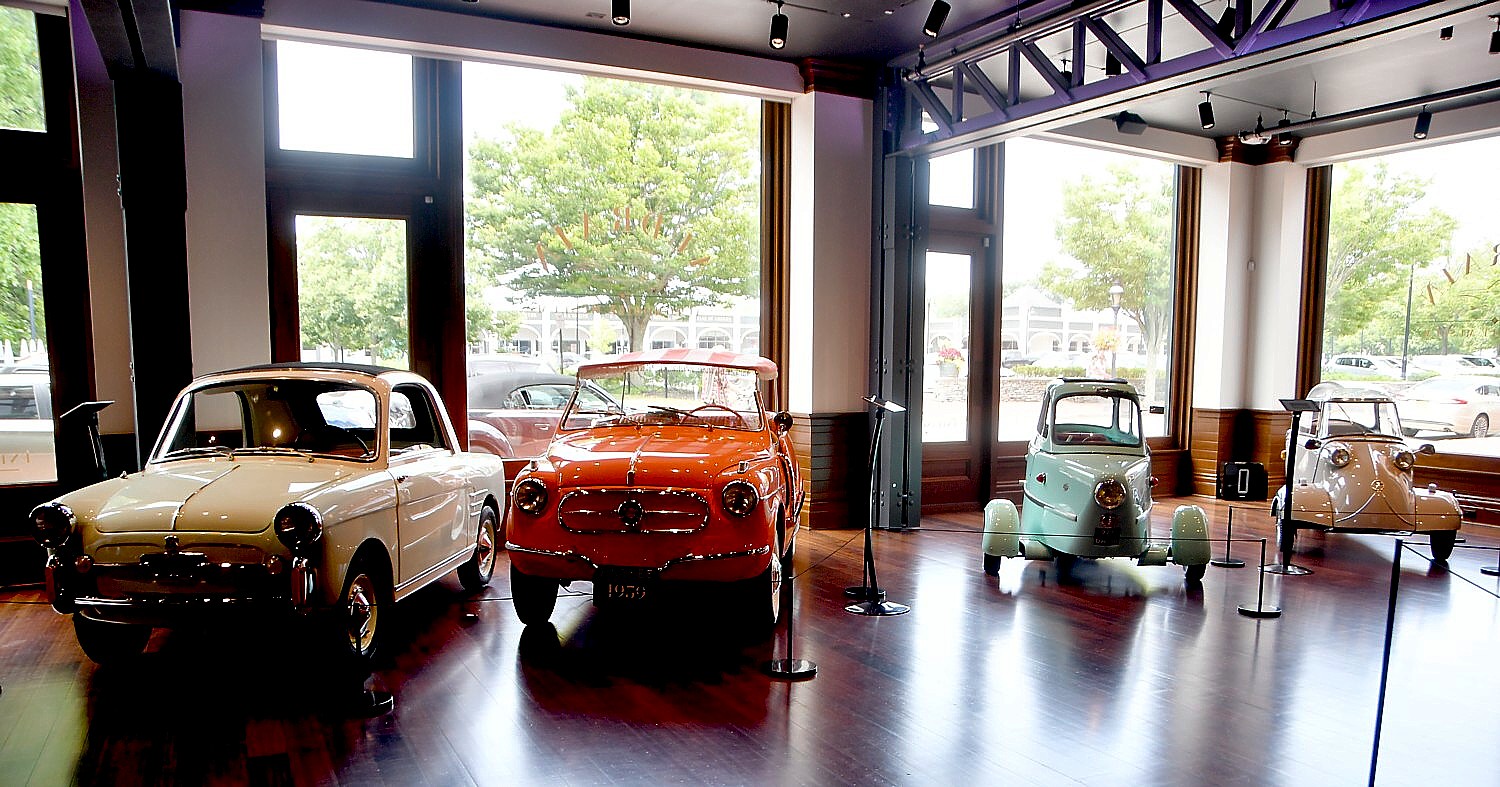
We enjoy a marvelous lunch at Annie’s bistro café (176 Bellevue Ave., anniesnewport.com) – elegant dining in a casual atmosphere and the best New England clam chowder anywhere –before hopping a trolley-style bus for a short ride to Marble House (you can see the schedule on googlemaps.com on your smartphone).
Andrea returns us to the Grande Caribe, where it is too late to explore inside the fort, but I walk along the Bay Walk (a 2.5 mile loop with gorgeous views of Narrangansett Bay and Newport Harbor) before returning to the ship for the cocktail hour and dinner. (Blount Small Ship Adventures, 800-556-7450, www.blountsmallshipadventures.com).
This was what you could do with one full day in Newport. There is so much more to do, and so deserving of a return multi-day visit. Top on my list: Doris Duke’s Rough Point (newportrestoration.org); Touro Synagogue and Loeb Visitors Center (tourosynagogue.org), Redwood Library and Athenaeum (opened in 1750 and has a collection of more than 200,000 titles, www.redwoodlibrary.org), and The National Museum of American Illustration (americanillustration.org), to list but a few.
See more and plan your visit: Discover Newport, 23 America’s Cup Avenue, Newport, RI 02840, 800-326-6030, 401-849-8048, www.discovernewport.org.

The Grande Caribe will next sail to New Bedford (see A Spectacle in Motion: Grand Panorama of a Whaling Voyage ‘Round the World is Once-in-a-Lifetime Must-See at New Bedford Whaling Museum) and on to Martha’s Vineyard.
Blount Small Ship Adventures, 461 Water Street, Warren, Rhode Island 02885, 800-556-7450 or 401-247-0955, info@blountsmallshipadventures.com, www.blountsmallshipadventures.com).
See also:
_____________________________
© 2018 Travel Features Syndicate, a division of Workstyles, Inc. All rights reserved. Visit goingplacesfarandnear.com, www.huffingtonpost.com/author/karen-rubin , and travelwritersmagazine.com/TravelFeaturesSyndicate/. Blogging at goingplacesnearandfar.wordpress.com and moralcompasstravel.info. Send comments or questions to FamTravLtr@aol.com. Tweet @TravelFeatures. ‘Like’ us at facebook.com/NewsPhotoFeatures

